Delivery of PRO plus Multi-Vendor via the integrator of delivery services and transport companies ApiShip for the marketplace
ApiShip is the largest consolidator of transport companies, which facilitates the delivery process for marketplaces. It unites more than 40 delivery services, automates the creation of a delivery order, prepares accompanying documents, and tracks the process of cargo delivery.
The ApiShip module connects the marketplace site and the ApiShip service. That is, you install one module for managing delivery services, instead of forty. This speeds up the work of the site, reduces the load on the server. In addition, it removes the issue of compatibility conflict.
Managing interaction with transport companies is available in the personal account for both the marketplace administrator and the seller.
The module automatically generates an order for delivery to a transport company and generates address labels, waybills and acceptance and transfer certificates of goods. The vendor prints these documents and attaches them to the boxes. In this form, he passes the order to the transport company. Then the vendor tracks the movement of the cargo through the personal account. The ApiShip module automatically changes the delivery statuses in the personal account.
The contract with the transport companies is concluded directly.
Aggregator and consolidator
We are talking about two different approaches to mediation between the marketplace and transport companies.
Aggregator is a company that enters into contracts with different transport companies, promising to bring a lot of customers, and getting more favorable conditions for this. Then the company enters into contracts with customers, adding its own percentage to the cost of the transport company's services.
You enter into a contract with the aggregator on the terms offered by him. And pay not directly to the transport company, but to the aggregator. Accordingly, the aggregator assumes responsibility for the delivery and integrity of the cargo.As a result, you get a small discount, plus simplify interaction with transport companies: one contract, instead of several for each company separately.
The consolidator is a company that undertakes only the creation of orders under your contract to various transport companies. At the same time, you have the opportunity to negotiate with a transport company on more favorable terms for you, for example, if you have a sufficiently large volume of deliveries. In this case, the benefit may be significantly greater than when working with an aggregator.
List of delivery services
- 5Post,
- Accotdpost;
- Axilog;
- Az.Express;
- B2Cpl;
- BoxBerry;
- CheckBox;
- CityExprass;
- CSE;
- Dalli-Service;
- Dostavista;
- Dostavka-Club;
- Dostavka.GURU;
- DPD;
- DRH Logistic;
- EASY BULKY;
- Gett;
- Hermes Russia;
- IML;
- Logsis;
- MaxiPost;
- NEPPOST;
- On-Time;
- OZON Roket;
- PickPoint;
- Pony Express;
- SmartDostavka;
- SmartSend;
- TopDelivery;
- Viehaly;
- Vozovoz;
- Business lines;
- E-KIT;
- TAKE IT.roo;
- To-Place;
- L-Post;
- Russian post;
- PEC Easywey;
- RU-DELIVERY;
- Sberbank statistics;
- SDEC.
Check the current list of transport companies on the ApiShip website
Module operation process
The ApiShip module organizes the interaction of the marketplace site with the selected delivery services, regardless of which of the two models is used to build interaction with sellers:
- The marketplace itself delivers the goods to the buyer;
- The vendor delivers the goods to the buyer on its own behalf.
Delivery of goods on behalf of the marketplace
In this case, the marketplace delivers the goods on its own behalf. Accordingly, the contract with transport companies is concluded on behalf of the marketplace.
The marketplace receives an order from the buyer and money, both for the product itself and for its delivery to the specified address. Then, if the seller's goods are stored in the warehouse of the marketplace, the warehouse employees pack the order and transfer it to the courier of the transport company.
If the goods are stored in the seller's warehouse, then he packs the order himself, brings it to the order acceptance point and hands it over to the transport company on behalf of the marketplace.
In this case, delivery management is completely carried out on the side of the marketplace. If the buyer does not pick up his order from the PVZ, they are returned to the warehouse under the marketplace agreement. He also pays for the movement of goods in this case. The higher the turnover, the lower the delivery price, both for sellers and buyers.
Delivery of goods on behalf of the seller
The module connects more than 40 transport companies for sellers.
The buyer places an order. Based on the parameters of the goods that he added to this order, the shipping cost will be calculated for him. However, it is important to understand that the actual cost of delivery depends not only and not so much on the size and weight of each individual product in the order, but also on how exactly the goods will be arranged and packaged together.
In addition, the seller may for some reason not specify the actual dimensions and weight of the goods in the product card. In this case, the default parameters specified in the module settings are used to calculate the cost of delivery. Naturally, not all products fall into these parameters.
This may change the cost of delivery when transmitting information to the transport company. Sometimes, the difference can be up to 30%. The marketplace may be in the red.
To avoid this, some marketplaces offer sellers special conditions: they reduce the commission percentage for the seller, but at the same time they ask to make the delivery free for the buyer.
In this case, the seller delivers the goods at his own expense and from his contract.
At the same time, the module automates the process of transmitting order information to the transport company via the marketplace. That is, the buyer places an order, the marketplace calculates the estimated cost of delivery for the seller, then, when the seller downloads information about the packaging of the order, recalculates a more accurate price and transfers the order to the transport company. The seller only has to pack the order, print out the accompanying documents and transfer the box to the transport company. At the same time, the seller will be able to track the path of the parcel in real time on the marketplace website: 19 status options indicating the exact state of delivery at a given time.
At the same time, if there is a two-factor payment on the site, with funds frozen on the buyer's account, then at the time of transfer of goods to the transport company, the money on the buyer's account will be unfrozen and transferred to the seller. And at the time of delivery of the goods to the buyer, a receipt will be knocked out. Also, this functionality returns money to the buyer if the buyer did not pick up the goods from the PVZ.
Chain from ordering to completion of delivery
- Creating an order, freezing money (optional);
- Status change to "Accepted by the transport company", money is transferred to the seller's account (optional);
- The order is on the way, each point of this path is marked with the corresponding status: accepted by the transport company, transferred for sorting, ready for delivery, issued;
- The goods were issued to the buyer, a receipt for the goods was issued on behalf of the seller;
- If the buyer did not pick up the goods from the PVZ, after the expiration of the storage period, the transport company returns the goods back to the seller's warehouse, the status changes to "Canceled", the money is returned to the buyer (optional).
Each seller chooses the transport companies with which he is ready to work. For each transport company, he can create several delivery methods, for example, for transporting goods of different categories. Often, for jewelry and some other categories of goods, transport companies require a separate contract, since they require other types of transportation.
Setting up transport companies
The seller enters into a contract with the transport company and logs in through the marketplace website using the ApiShip module. The marketplace administrator checks the availability of the transport company and the selected tariff. And if everything is in order, then he sets up the necessary delivery methods for specific tariffs for the seller.
Also, the marketplace can give the seller the opportunity to independently configure delivery methods taking into account his needs. In this case, the seller can only check the correctness of the settings and approve them.
For convenient configuration of delivery methods, the administrator can limit the seller's choice of tariffs of the transport company in advance. For example, CDEK has a huge number of tariffs, and there is no need to dump information about all of them to the seller.
Therefore, the administrator initially specifies the tariffs that the marketplace works with in the settings. The seller, setting up the delivery method, sees only those tariffs that the administrator has confirmed.
Calculation of the cost of delivery and transfer of data to the transport company
The module calculates the cost of delivery based on the tariffs on the transport company's website. However, for a number of reasons, it may not work. This may be technical work on the site, server reboot, and so on.
If you request information about tariffs at this moment, the calculation of the cost of delivery will not be available. Without receiving the necessary information about the cost of delivery, the buyer can go to another site.
To avoid this, the module stores in memory the latest received data on the tariffs of the delivery service, and in case the website of the transport company does not respond, it uses information from memory for calculation. That is, the shipping cost will be calculated in any case.
He also saves his calculations in memory, and as soon as the transport company's website starts working, he immediately transmits information about the order with the exact cost. This greatly facilitates the process of setting up transport companies, and, therefore, facilitates the process of entering the seller on your trading platform.
Order validation before packing
After placing an order, information about it is sent to the transport company to make sure that the specified by the buyer is correctly recognized in the transport company.This is necessary in order to exclude the refusal of delivery due to an address not correctly read.
This is especially true for residents of the Moscow region. Now it includes many districts and small villages that were previously considered independent settlements. And when writing down an address, it is important to specify all its components. In addition, there are cases when the actual address is located in one locality, and the address of the post office to which the specified building belongs is located in a neighboring locality. Even if two houses are located across the street from each other.
Different transport companies may record such addresses in different ways. A striking example is, for example, the address of the new fulfillment warehouse of the Russian Post – Vnukovo-2. Even in different maps it is indicated differently. So, Google Maps shows the address: Naro-Fominsky district, 102976, village. Marushkinskoye, d, Sharapovo, Moscow region, 143390, and Yandex.Maps indicate a different address: Russia, Moscow, Marushkinskoye settlement, block No. 63, dv1s2.
For the module to work correctly, it is necessary to match the fields of the seller's profile and the fields of the buyer's profile in the settings. This increases the accuracy of information transmission.
Often people enter incorrect information as an address. For example, the numbers of houses or apartments are written in text, not numbers, or without separating commas. There may also be typos in the street names.
Another possible problem is when the PVZ point, which the buyer has chosen, is planned to be closed in the near future. Information about the work of branches is not always transmitted in a timely manner.
Sending the order to the transport company after confirmation
There are cases when the buyer is not completely sure about his order. They need to be contacted, consulted, if necessary, to make changes to the order. If you immediately send information about such an order to a transport company, then you will have to make changes to it later, sometimes more than once.
To avoid this, the ApiShip module sends the order to the transport company only after the order receives the status "Ready to be sent to the transport company".
Using a separate cargo space
Goods of different sizes are shipped by many transport companies at different rates. Therefore, if, for example, a T-shirt and an ottoman appear in one order, the transport company may refuse to transport such an order. The fact is that orders are added up and counted as one shipment, which under such conditions may not correspond to the parameters of any tariff of the transport company.
In addition, products such as a microwave oven or other household appliances in their original packaging do not require additional packaging in boxes.
Therefore, we have added to the ApiShip module the ability to issue some goods as a separate cargo place. When filling out the product card, the seller indicates that this product is delivered as a separate cargo.
And if the buyer puts T-shirts and a microwave in the basket, or they are packed separately from each other and counted as different shipments. Thanks to this, each of them will easily fit into the parameters of their tariff.
We also added the ability to edit the cargo of the place. This is done in case the size of the product does not fully correspond to those indicated in the product card.
Default dimensions
The tariffs of transport companies have their own limitations. Moreover, not only the upper border is limited, but also the lower one. And if the minimum weight in the tariff is 100 g, then the cost of delivery of such goods as, for example, seeds or spare parts for the phone will not be calculated. Their weight is significantly less than the minimum.
To solve this problem, we have added the ability in the settings of each tariff to specify the minimum size of the goods by default, which are transferred to the transport company if the size of the goods is less than the minimum requirements in the tariff.
Thanks to this, it is possible to send goods weighing from 0.5 g and measuring from 0.5 cm on either side.
Also, default dimensions are required when not all delivery parameters are specified in the product card, for example, if incomplete information is received from the supplier.
Tariff Guide
We have added a tariff directory to the module. When filling out information about the order packaging, the module checks the dimensions of the boxes, the weight and the cost of the shipment and compares them with the tariff restrictions. If the shipment does not meet these requirements, the module will highlight the corresponding field in red.
Order communication
In some cases, it may be necessary to make changes to an existing order. For example, if the buyer wanted to change the quantity of goods in the order, or the seller's warehouse did not have the right quantity of goods. However, the created order already appears in various documents and systems of the site.
Therefore, instead of editing the old order, the module creates a new order with the specified quantity of goods, and associate it with the already created shipment in ApiShip. To do this, the ID of the desired shipment is indicated in the corresponding field. The order status will change automatically.
Prefixes
We have added the ability to create prefixes to the module. By the prefix, the seller will immediately understand at which site the order was created and to which transport company it will be sent.
Cargo pickup from the warehouse
Almost every transport company has tariffs under which the courier picks up the cargo from your warehouse and delivers it directly to the buyer. For the buyer, such delivery is especially expensive, as a rule, from 300 rubles.
However, if your customers often use the services of a particular transport company, and you have more than 10 orders per day, then you can order a mass cargo pickup. The transport company arrives 1-2 times a day, depending on the number of orders, and takes everything prepared by this time and delivers it to its warehouse for sorting. The cost of this service is significantly lower, which reduces the cost of delivery for the buyer.
Setting up additional services
Each transport company has its own set of additional services:
- Cash on delivery;
- Payment by card upon receipt;
- Delivery of several items for fitting;
- Product control;
- Partial issuance and so on.
All additional services can be configured for each tariff in the personal account on the marketplace website for a specific transport company and a specific tariff. You get the most flexible tool for setting up all transport companies in one place.
Beta: Creating delivery methods from a template
No matter how detailed the instructions for creating delivery methods for vendors are, you still can't be sure that they will set everything up correctly. Ready-made templates of delivery methods for vendors will allow them to create delivery methods in a few clicks, while not making mistakes in the settings. This will make it much easier for vendors to enter your site.
Compatibility
In combination with the Logistics module, it automatically makes delivery from the seller's warehouse.
The module is also compatible with the following modules:
- Assembly order (collection of cargo to the final buyer);
- Purchase order (collection of orders to the sorting point for sorting and delivery to the buyer);
- Delivery order (collection of cargo to the sorting point for repacking and delivery to the buyer);
- Order for acceptance (collection of cargo for movement between warehouses).
MODULE SETUP
1. After installing the module, go to the "Modules" tab, select "Module Management" and "MAURISWEB" from the drop-down menu.

2. In the list that opens, select the module you are interested in and click on its name, highlighted in blue or black.

3. Go to the "Main" tab. If the license key is not set automatically and the module settings are blocked, log in to your account at www.maurisweb.ru copy the license key and paste it into the appropriate item. The key has also been sent to your email.

4. Go down below, select the "Basic Settings" section and tick the "Save data when deleting the module" option so as not to lose them when reinstalling the module.

5. Go to the "Authorization" tab. Enter your username, password and API token to log in to your ApiShip Personal Account. This is necessary to synchronize the marketplace with the service.

This data is contained in the Dashboard section in the ApiShip Personal Account.

6.Go to the "Settings" tab. Check the box if you will use the test API. If you are using a test version of a Personal Account of a transport company, then check the box, if the version is combat, then do not put it.

7.Expand the additional menu in the item "Length units in your system" and select one of the suggested values: "mm", "cm", "m".
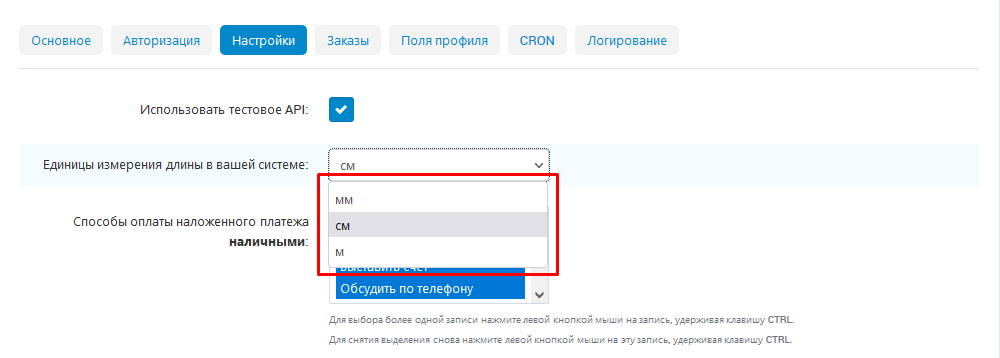
8. Specify the payment method to the courierin cashby default. To do this, in the item "Cash on delivery payment methodsin cash", select one of the suggested methods. For example: "Bank card", "Invoice", "Discuss by phone", etc. (depending on the payment methods you already have).To select more than one entry, left-click on the entry while holding the CTRL key. To remove the selection, left-click on this entry again while holding down the CTRL key.
Please note that different transport companies may have different payment requirements. In the settings, only the data that will be specified by default is displayed!
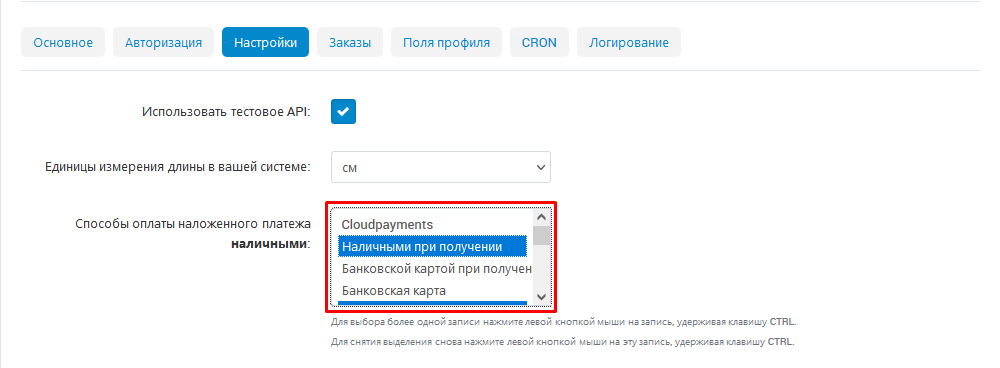
9. Specify the payment method to the courierby cardsby default. To do this, in the item "Cash on delivery payment methods by cards", select one of the suggested methods.
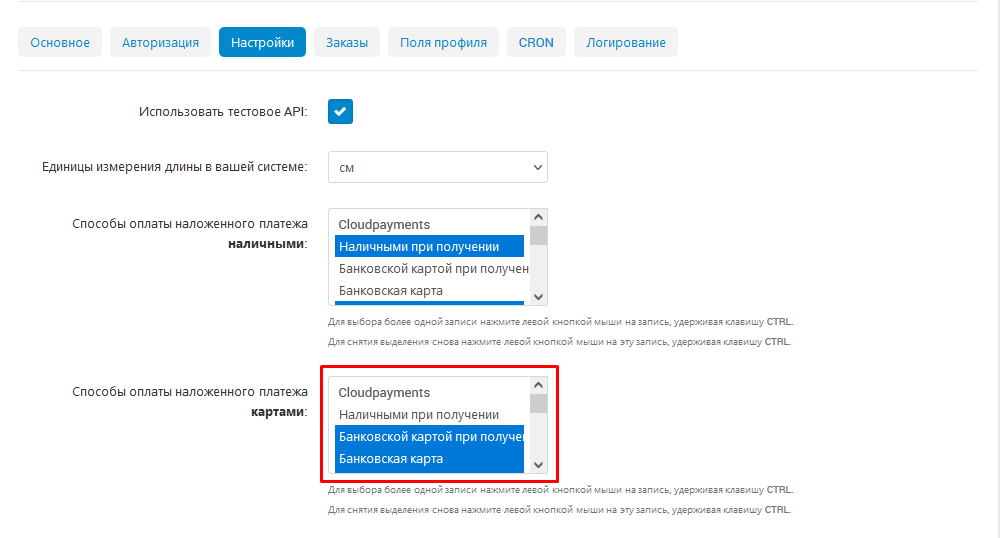
10. As a rule, the transport company includes insurance and cash on delivery in its services. To sum up the total cost of all fees of the delivery service in the receipt, check the appropriate box.

11. Indicate in numbers the waiting time for a response from the provider. If this period is exceeded, the request will be rejected.

12. Go to the "Orders" tab. Specify the prefix to the order number and the separator of the order number. With this prefix, orders will be created in the Personal Accounts of delivery services.

13.To send goods on behalf of the marketplace, check the appropriate box.

14. Check the statuses for which you need to make a change request for ApiShip. At the same time, the final status does not need synchronization.
For example, while the order is being processed, its status will be "Open" and the carrier does not need information about it. But the status "On hold" means that the process is frozen pending confirmation (payment or availability of goods) and will not be transferred to the carrier until its completion. The status "Completed" indicates the completion of the transportation, the buyer has received the order and he will not need to make a new request to change the status.
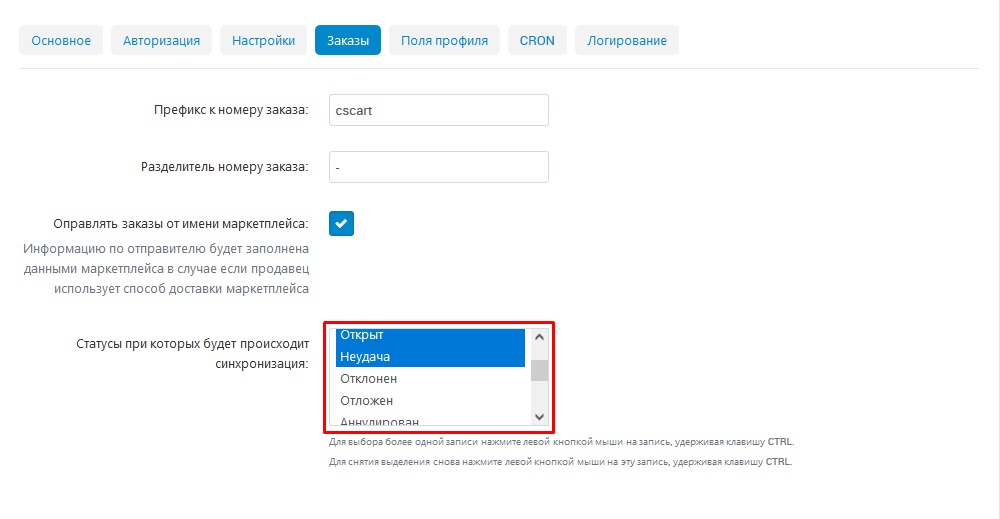
15. Go to the "Profile Fields" tab. In the "Buyer" section, select from which profile fields the information about the buyer will be indicated. If necessary, you can create your own profile fields (see the subsection "Profile Fields").

16. In the "Seller" section, specify the profile fields for the seller.
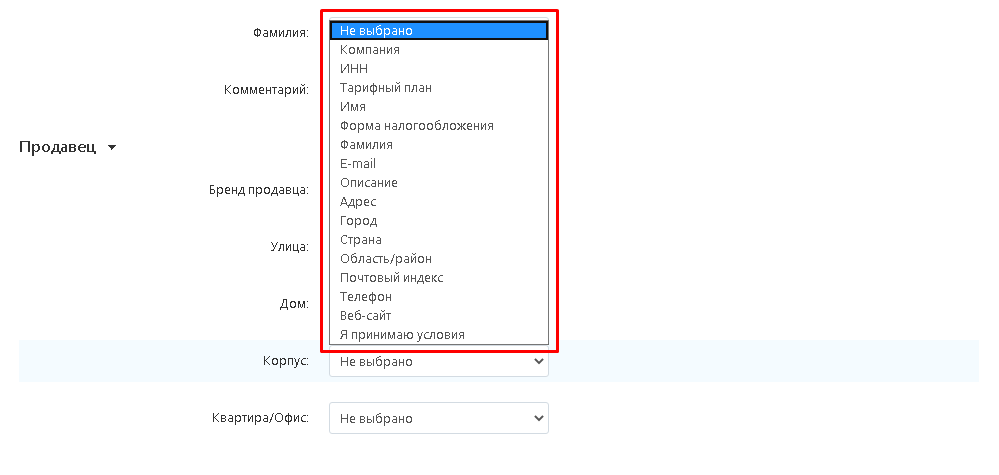
17. Go to the "CRON" tab. Enter the commands into the CRON scheduler. Note that the CRON job is configured on the server. The stability of the store will depend on the correct configuration.
Address for CRON settings (for example: php/var/www/mw/data/www/mwdevelopers.ru/admin.php - p --dispatch=maurisweb_apiship.send_orders.create) may differ from the control panel or other server settings. To configure the task, contact the server administrator.
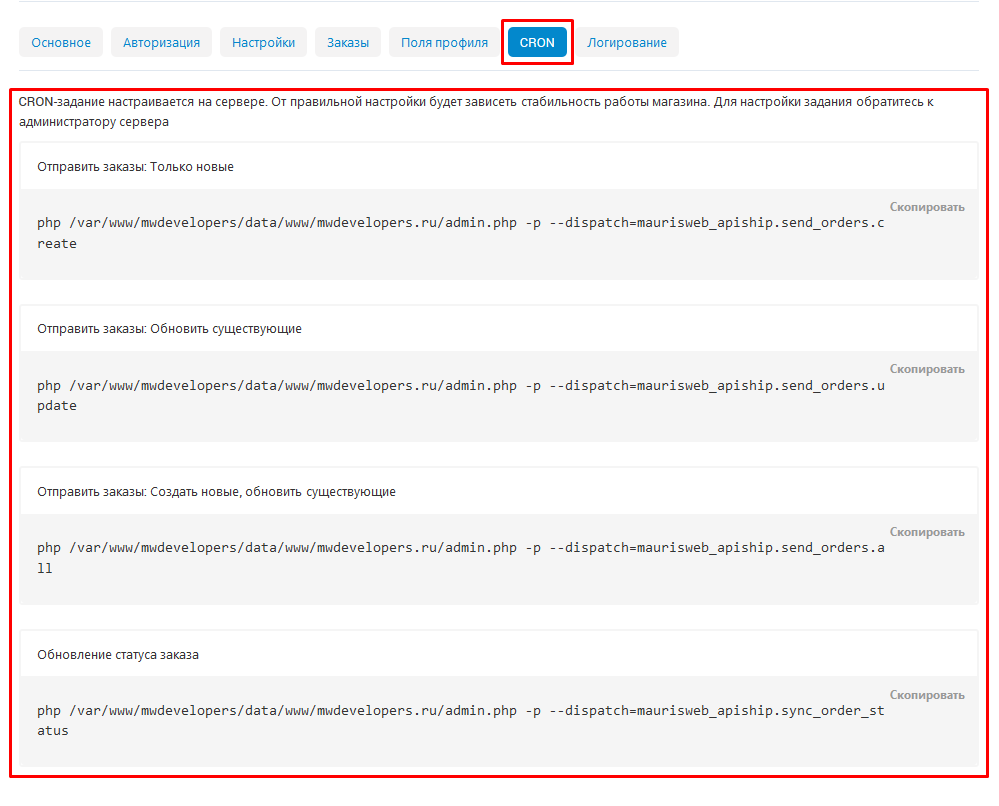
18. Go to the "Logging" tab and select the type of logging: "Not selected", "File system", "Database".

19. Save the module settings by clicking on the blue "Save" button in the upper right part of the screen.

PROFILE FIELDS
1. To create new profile fields, go to the "Administration" tab, select the "Profile Fields" section and then "Buyers and Administrators".

2. Click on the plus button in the upper right corner of the panel.

3. Fill in the required fields (marked with a red asterisk) and specify access to the profile in the "Profile (Show/Required).
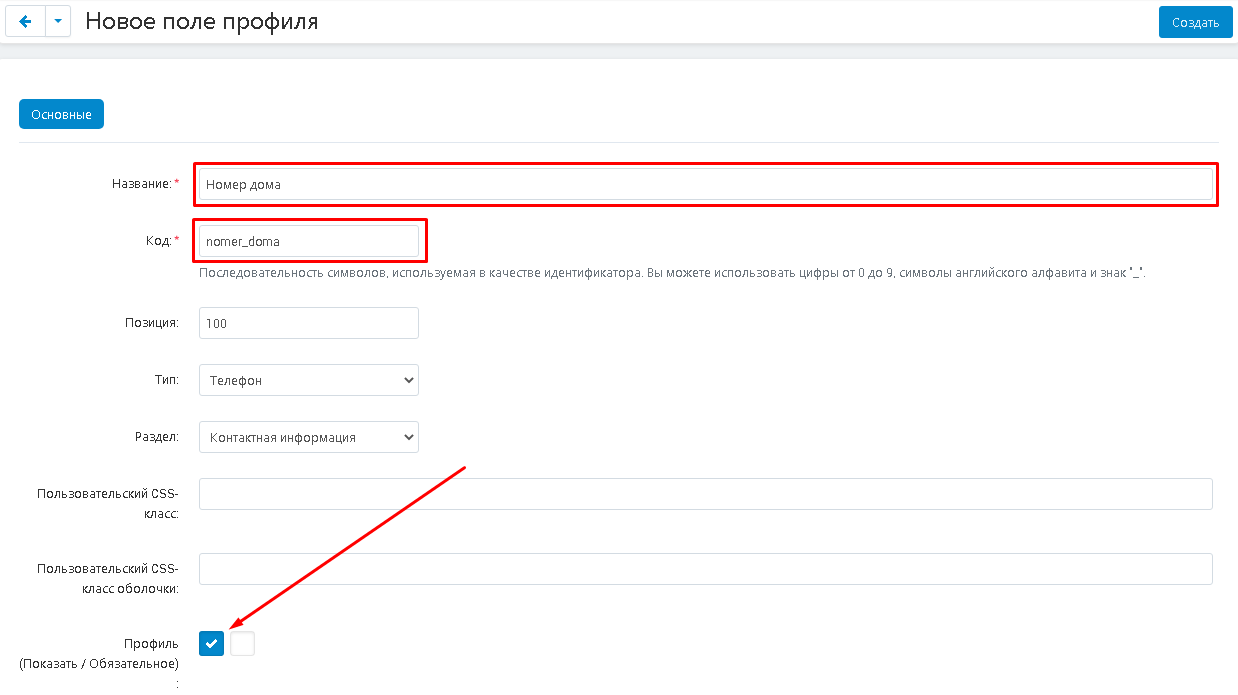
4. When all the fields are filled in, click on the "Create" button in the upper right corner of the panel.

5. If the profile fields are displayed in different sections with the same names (for example, in the "Address" and "Contact information" sections), it is recommended to add a distinction mark to one of them (*, !, @, etc.)
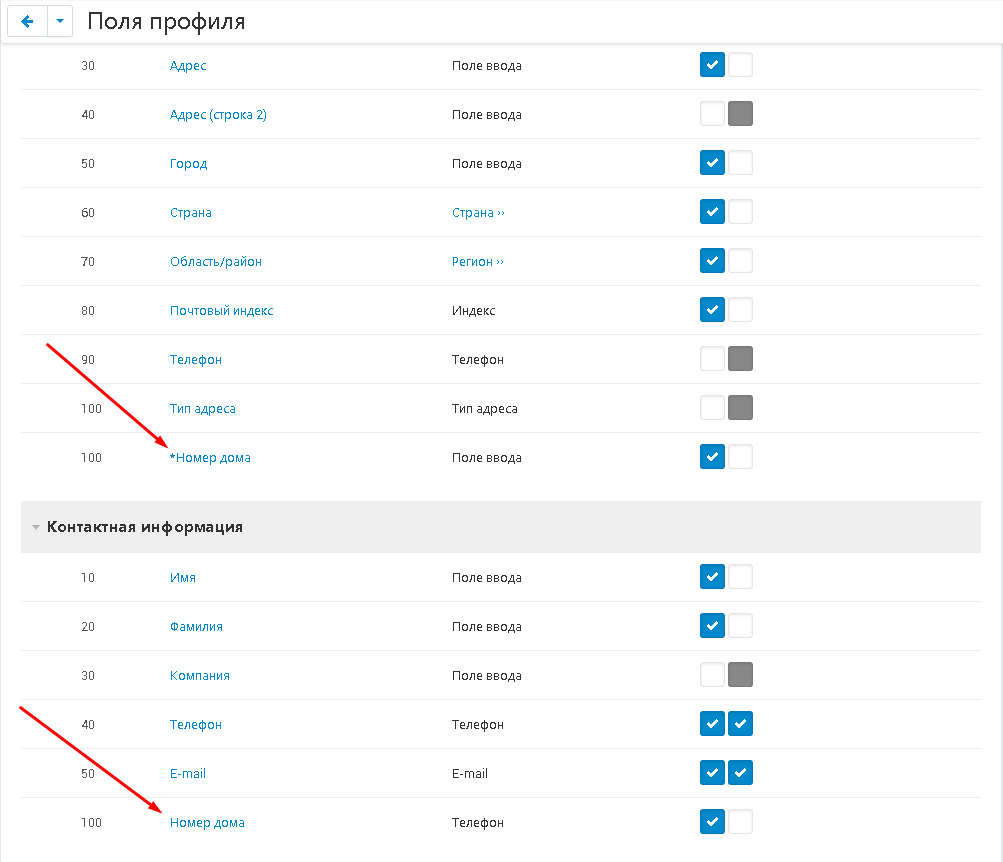
6. In this case, you will not make a mistake during the selection.

7. To make the profile fields appear on the checkout page, go to the "Design" tab, select the "Layouts" and "Layouts" section.

8. Go to the "Checkout" tab.

9. Go to the parameters of a ready-made block or create your own.
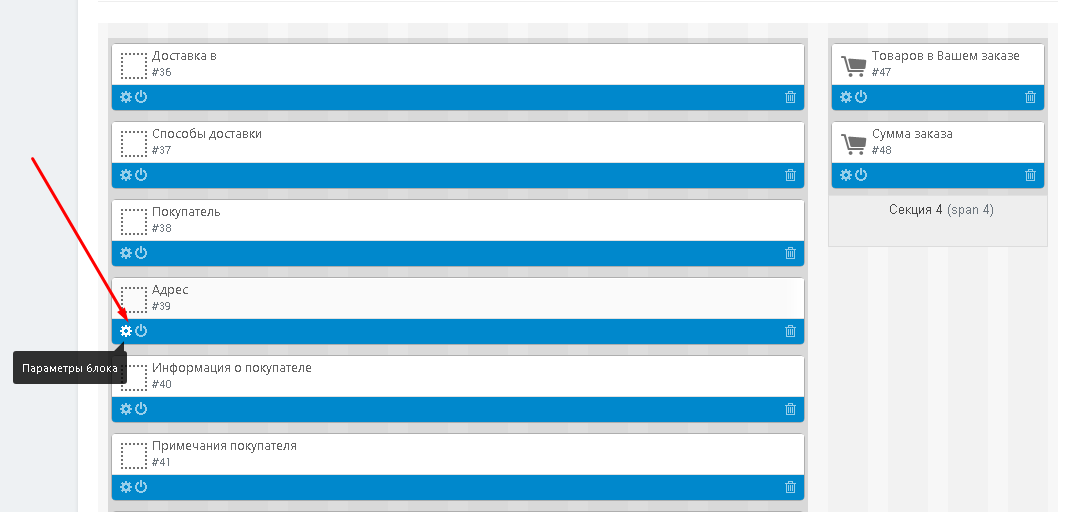
10. Go to the "Content" tab and click on the "Add profile fields" button.
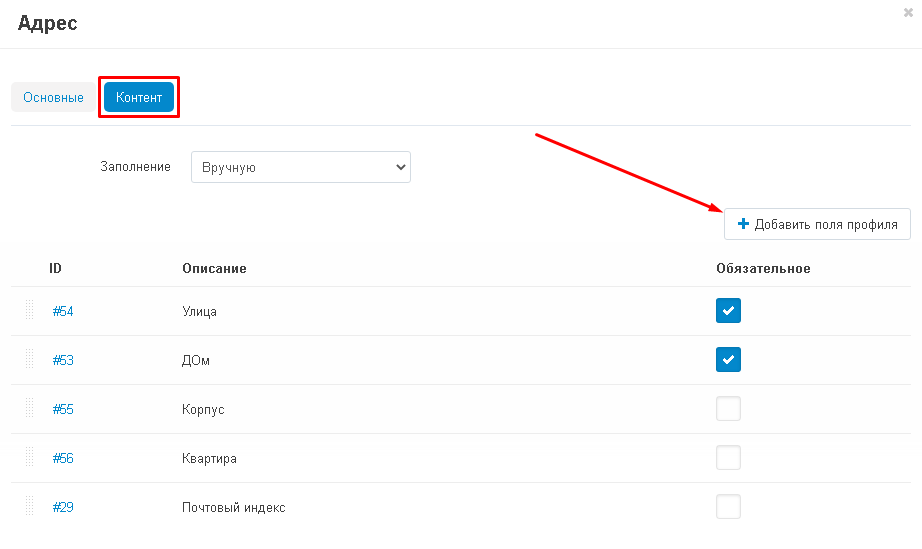
11. In the window that opens, tick the required profile fields. Click on the "Add profile fields" button to continue the selection or "Add profile fields and close" to complete the selection.
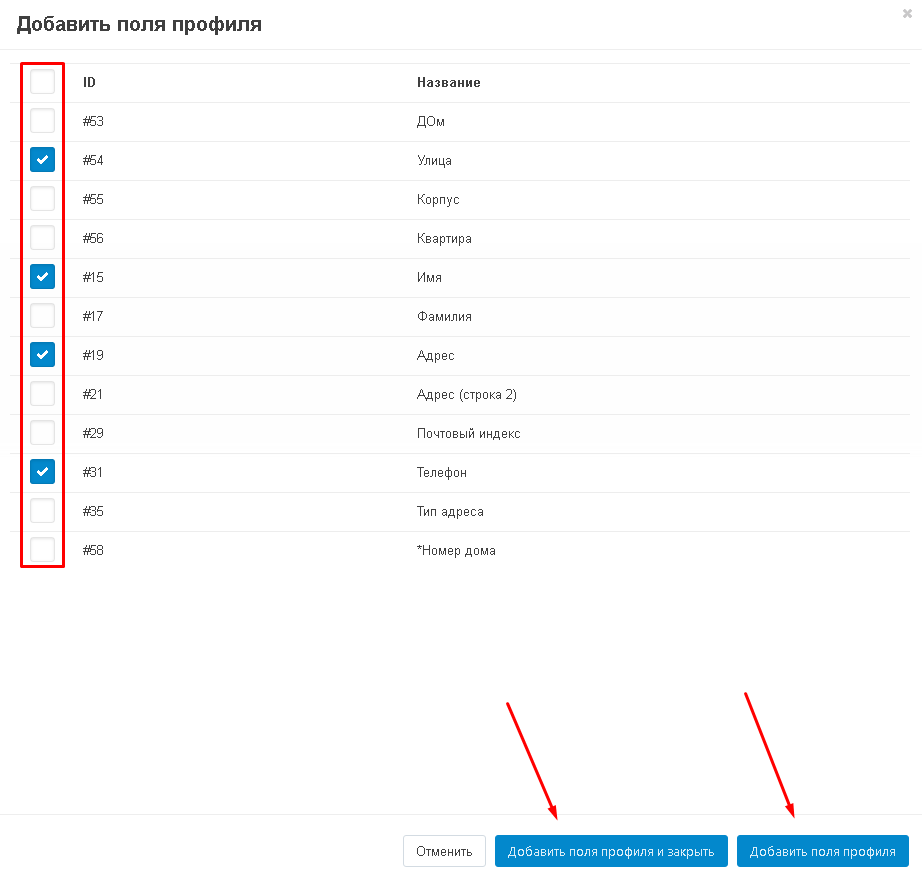
12. Save the changes by clicking on the button in the lower right corner.

PRIVILEGES
1. To configure privileges for a group of users, go to the "Buyers" tab and select the "User Groups" section.
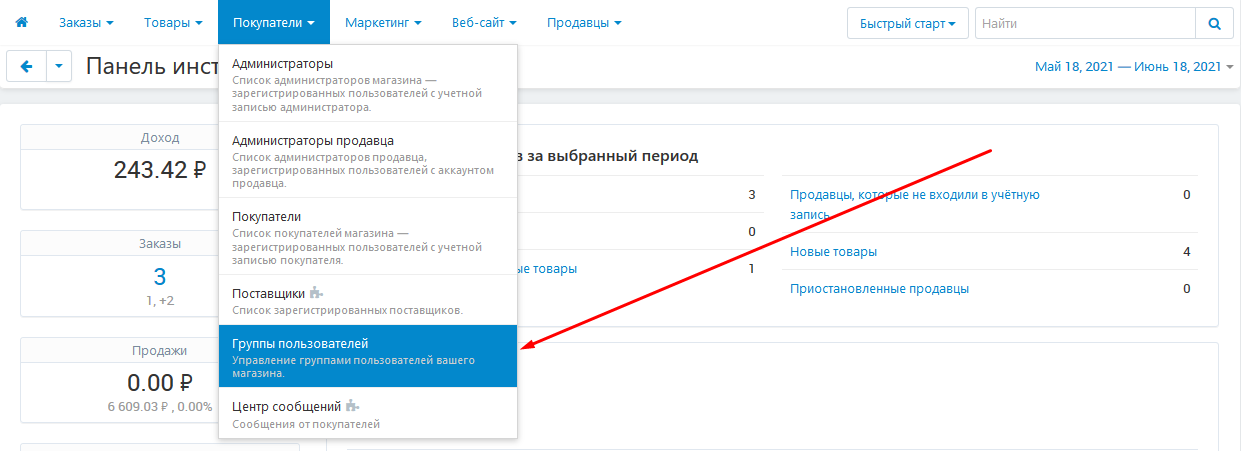
2. Select the desired user group and click on its name highlighted in blue.
Do not forget that in order to correctly configure the privileges of groups with the "Seller" type, the "Privileges for Sellers" module must be installed and enabled.

3. Go to the section "MW: ApiShip" and specify the access level for the items "Transport companies" and "Settings": "Full access", "View only", "No access".
The item "Transport companies" gives access to view and create TC, as well as to carry out their approval (only for administrators).
The "Settings" item allows you to change the order statuses.

4. Save the changes by clicking on the blue "Save" button in the lower right corner of the window.

APISHIP SYNCHRONIZATION SETTINGS
To synchronize the data of the ApiShip Personal Account with the platform, go to the "Modules" tab, the "ApiShip" section and select "Settings".

For the initial synchronization setup, be sure to follow the following order:
1. DELIVERY SERVICES
1. First of all, synchronize the data about the delivery services with the ApiShip Personal Account.

2. To do this, first click on the white button "Synchronize delivery services",

3. then "Synchronize rates".

4. The list of delivery services will be filled in automatically. If this did not happen, then check the module settings (see the section "MODULE SETTINGS"). It is possible that the authorization data was entered incorrectly (item 5) or the test mode is used incorrectly (item6).
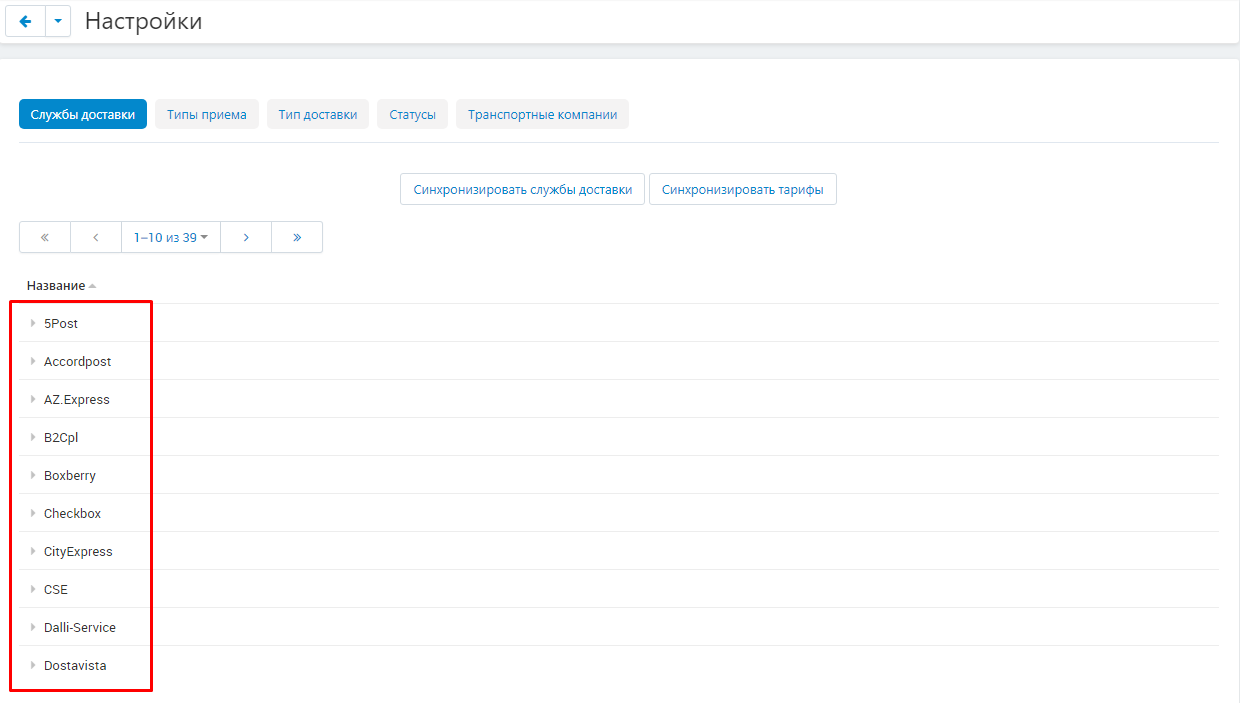
2. TRANSPORT COMPANIES
1. Information about carriers is contained in the "Transport companies" tab.

2. It is synchronized with the "Delivery Services" tab in the ApiShip Personal Account. In the "Connected" section there are those transport companies that can already be used. The rest are located in the "Available to connect" section.
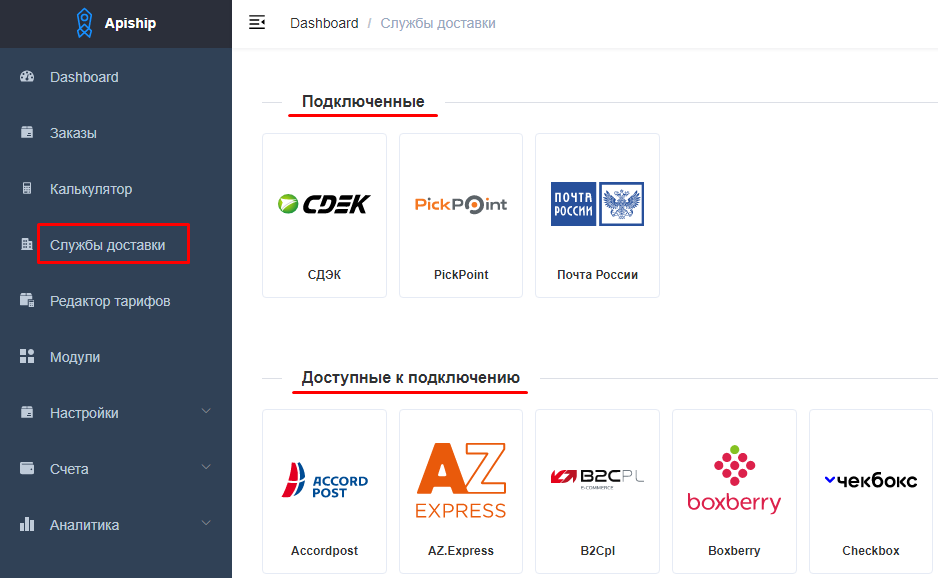
3. First click on the "Sync" button.

4. The connected transport companies will be displayed in the tab.
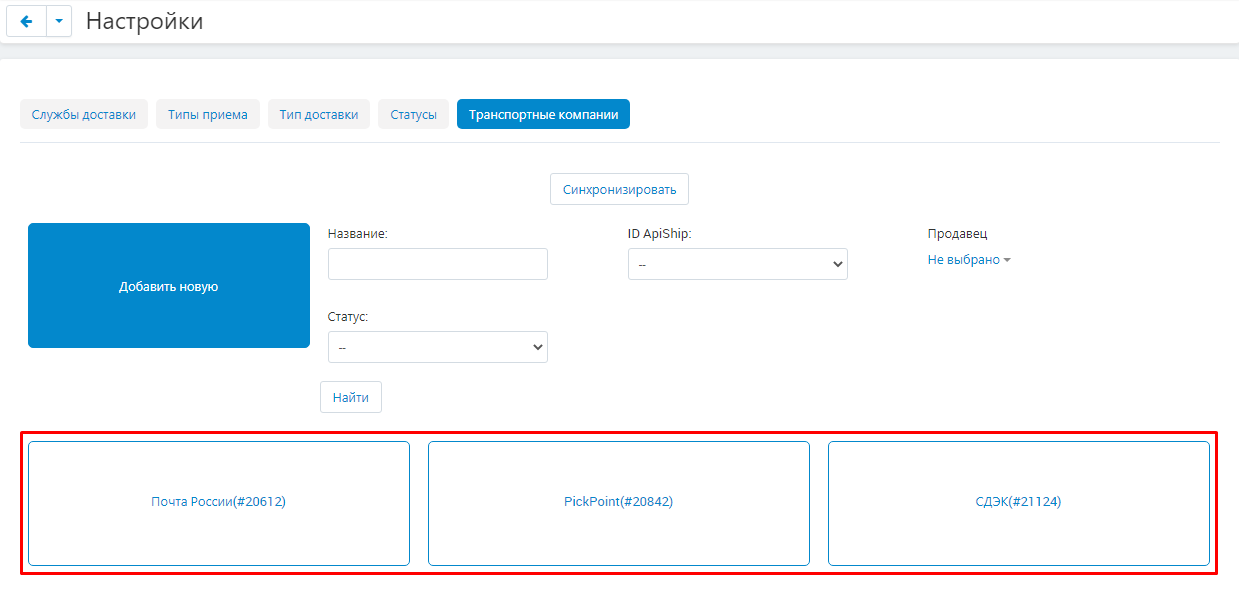
3. TYPE OF RECEPTION. TYPE OF DELIVERY.
1. Each time, after adding a new TC not through synchronization (for example, added by the seller), you need to synchronize the types of reception and types of delivery.
To do this, go to the "Reception Types" tab and click on the "Synchronize" button.

2. Then enter the "Delivery Type" tab and click on the "Sync" button.

4. STATUSES
1. For the correct synchronization of the store and transport companies, you need to correlate the statuses. To do this, go to the "Statuses" tab and click on the "Synchronize" button (especially after a new TC has been added).

2. The statuses of transport companies will be listed in the left column.
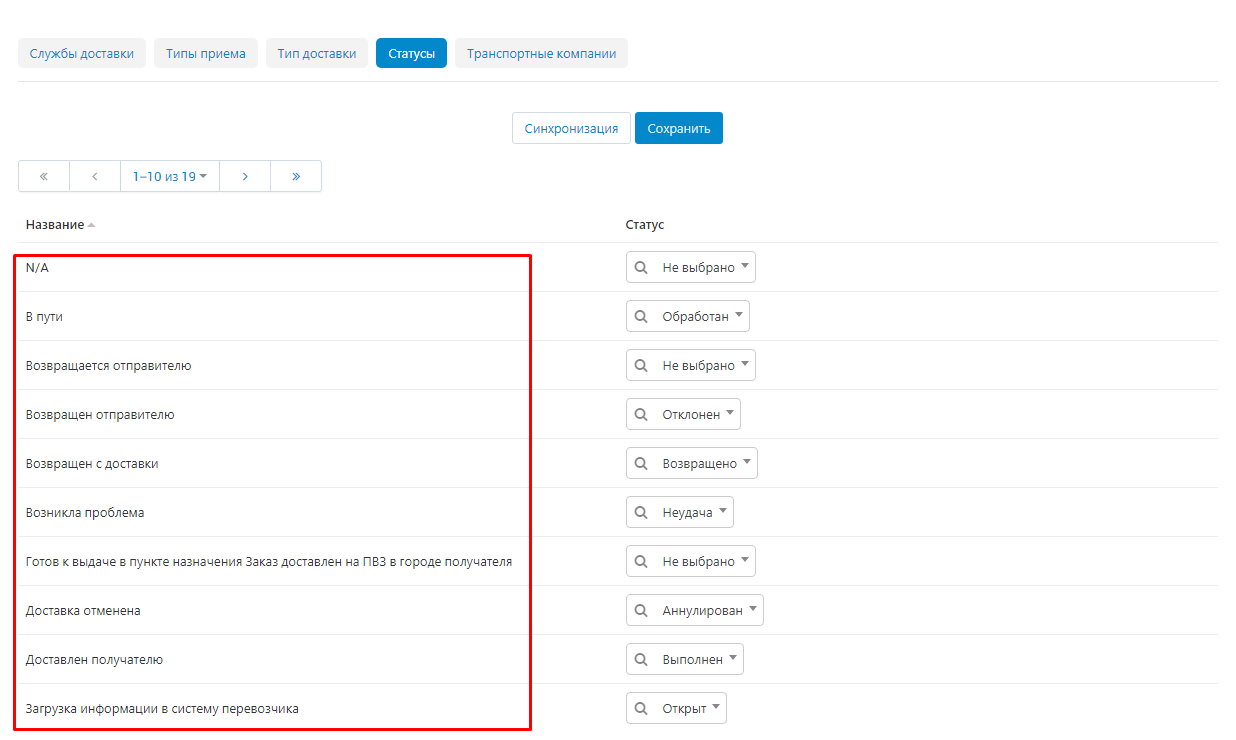
3. In the right - store statuses.
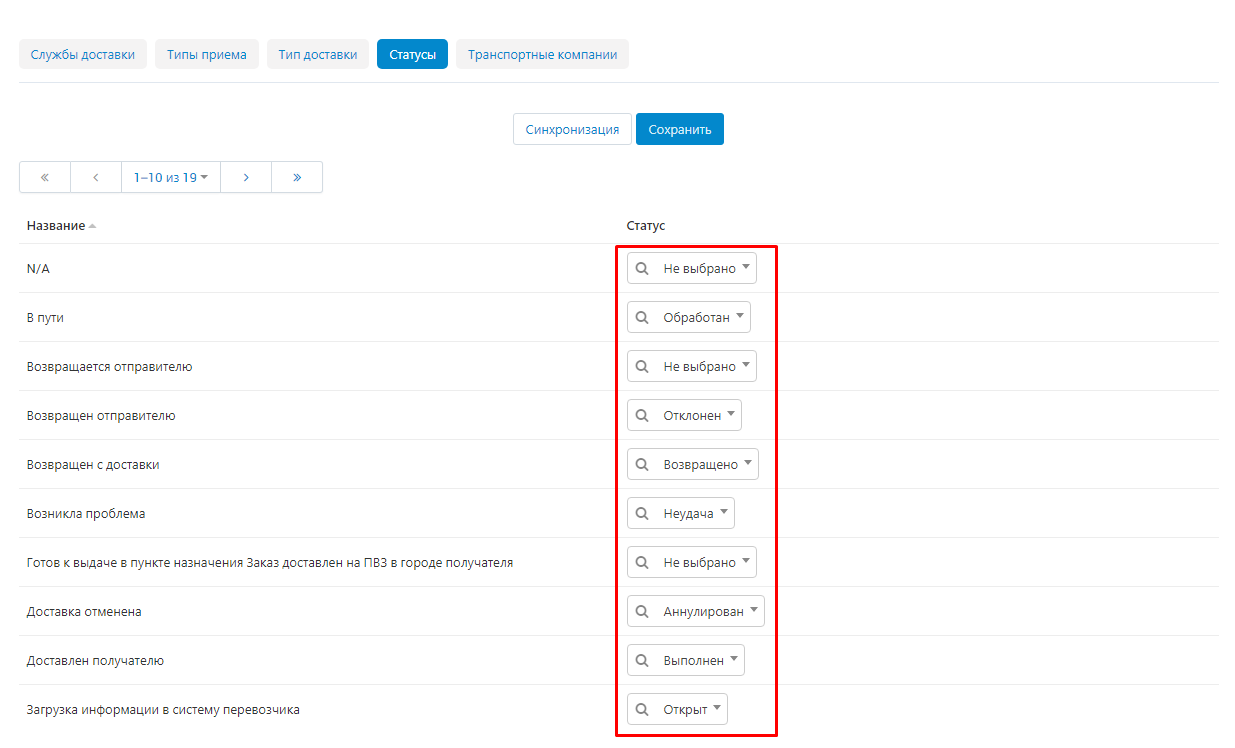
4. Expand the additional menu and select the status of the store, which will be correlated with a specific status for transport companies.
For example, the status of the transport companies "There is a problem" can be correlated with the status of the store "Failure". Now, when updating the order status by CRON, in case of a problem, the order status will change to "Failure".
You may not have to match all statuses, but it is recommended to do this for the maximum number so that there are no problems in the process.
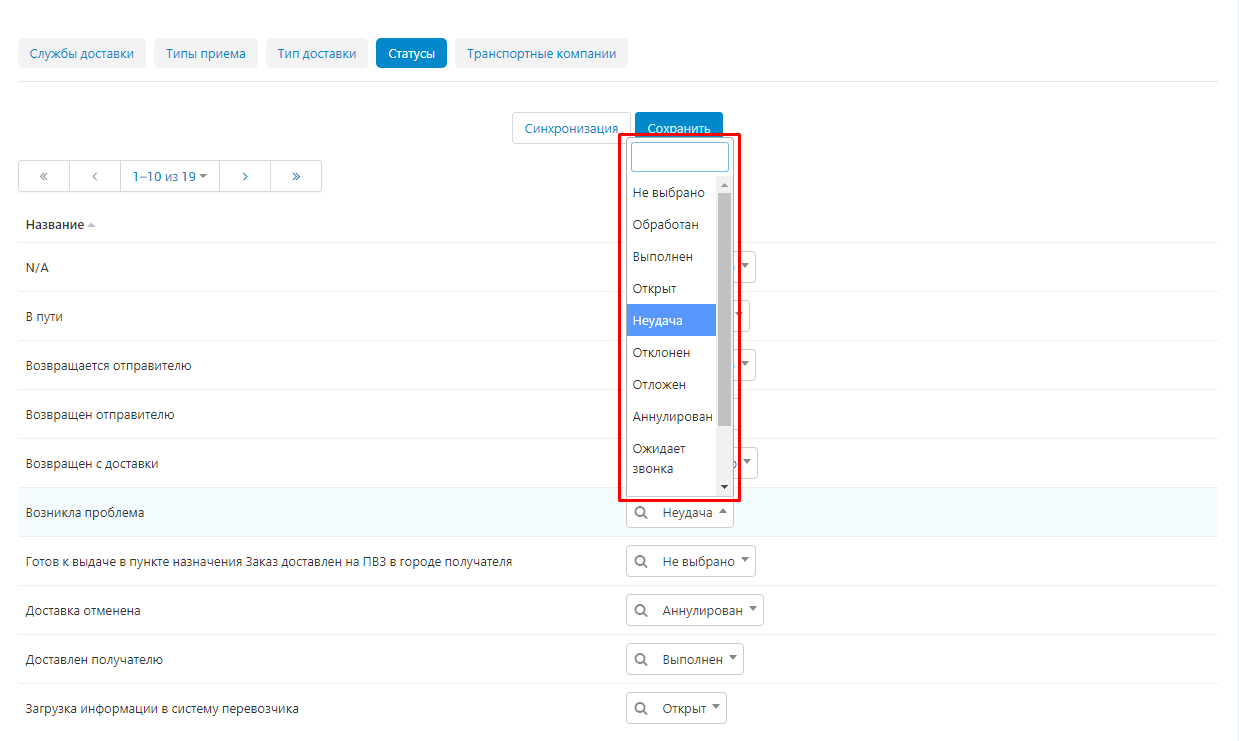
5. After the status matching is completed, click on the blue "Save" button.

ADDING A NEW TRANSPORT COMPANY BY THE SELLER
The seller can independently add a new transport company (TC), if he has the privileges for this. Also, the seller must have the correct address entered.
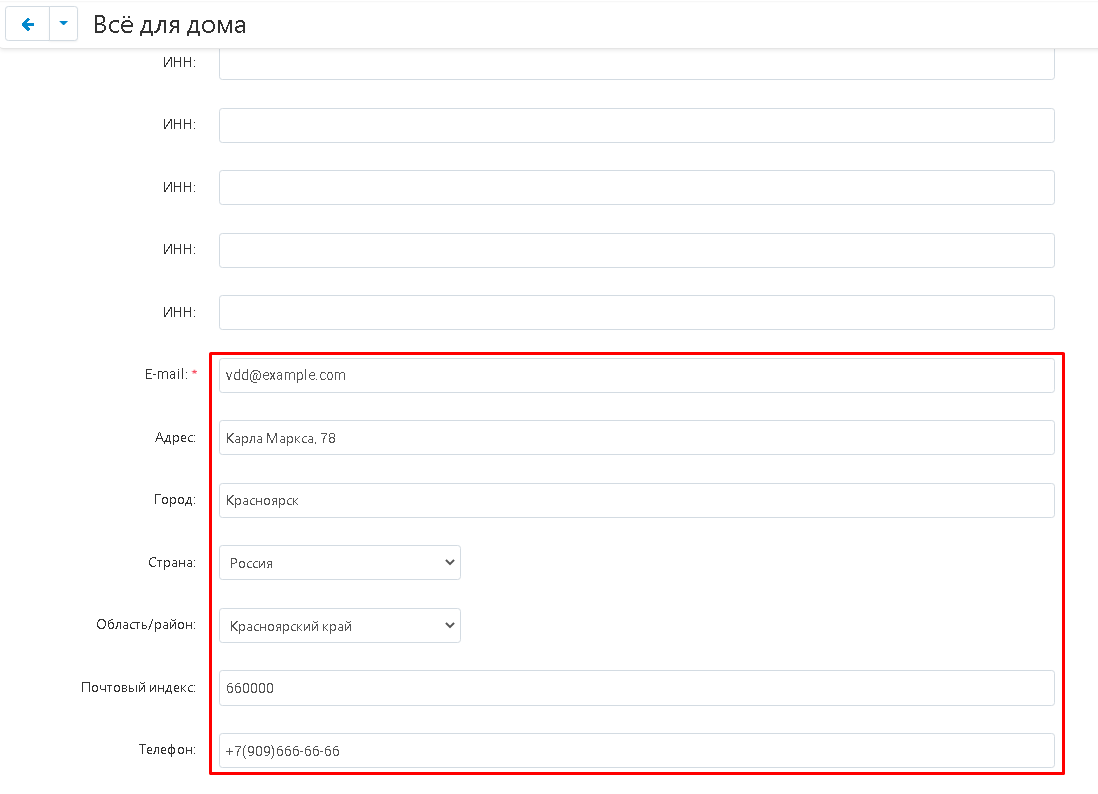
1. To add a new TC, in the seller's panel, go to the "Modules" tab, the "ApiShip" section and select "Settings".

2. Click the green "Add New" button.

3. Enter the name of the transport company you are adding.

4. Expand the additional menu in the "Delivery Service" item and select the desired company.
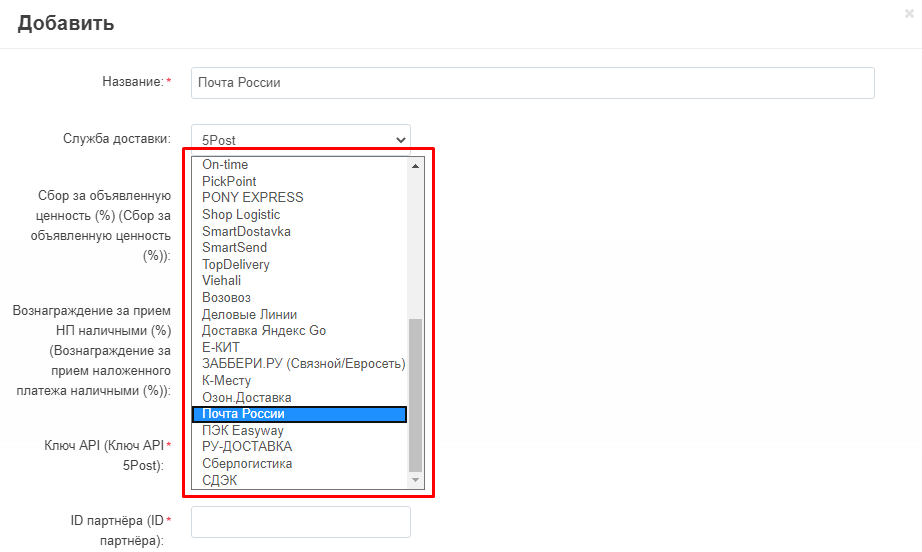
5. To fill in the data for creating a new TC, you need to log in to the ApiShip Personal Account and select the desired delivery service in the "Connected" section.

6. Inside there will be all the information to fill in the data about the new TC.
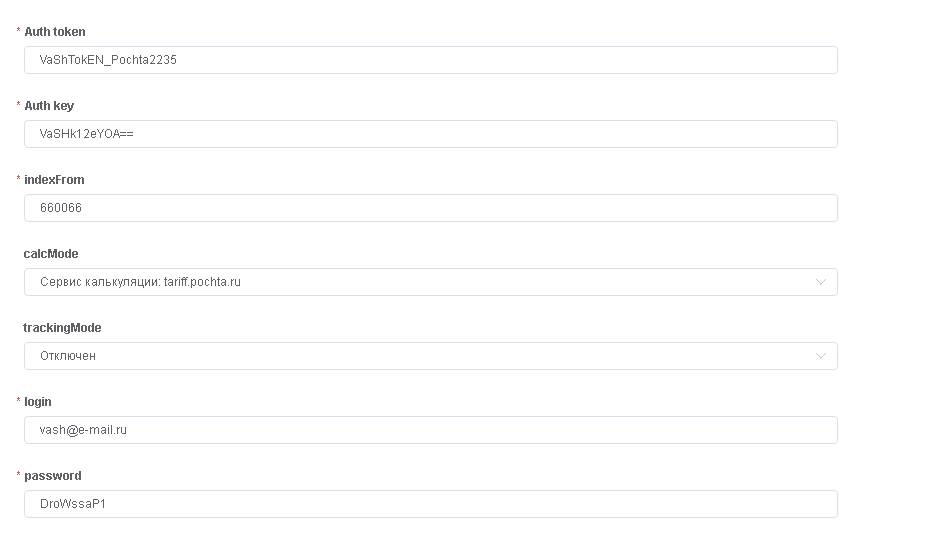
7. When all the data is filled in, click on the green "Save" button in the lower right corner of the window.

8. After that, the added TC will appear in the tab and will be marked in red until it is verified by the administrator.

VERIFICATION OF A NEW TRANSPORT COMPANY BY THE ADMINISTRATOR
1. After the seller has added a new TC, it must be checked by the administrator in order to use its services for the store.
To do this, in the admin panel, go to the "Administration" tab, the "Shipping and taxes" section and select "Transport companies".

2. Select the TC highlighted in red.
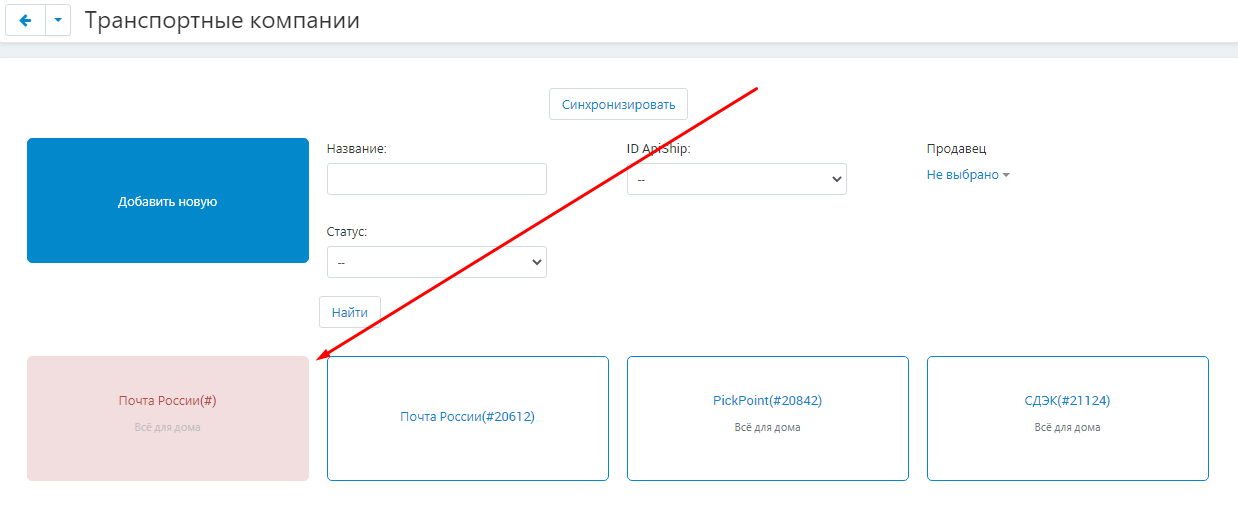
3. Set the status: "On" (enabled) or "Off" (disabled). And enter the ID in ApiShip.

4. The ID is located in the name of the TC in the ApiShip Personal Account (see paragraph 6 of the section "ADD A NEW TRANSPORT COMPANY BY THE SELLER")

5. After checking all the data of the new TC, click on the blue "Save" button in the lower right corner of the panel.

6. The red selection will disappear from the checked TC and now it can be used.
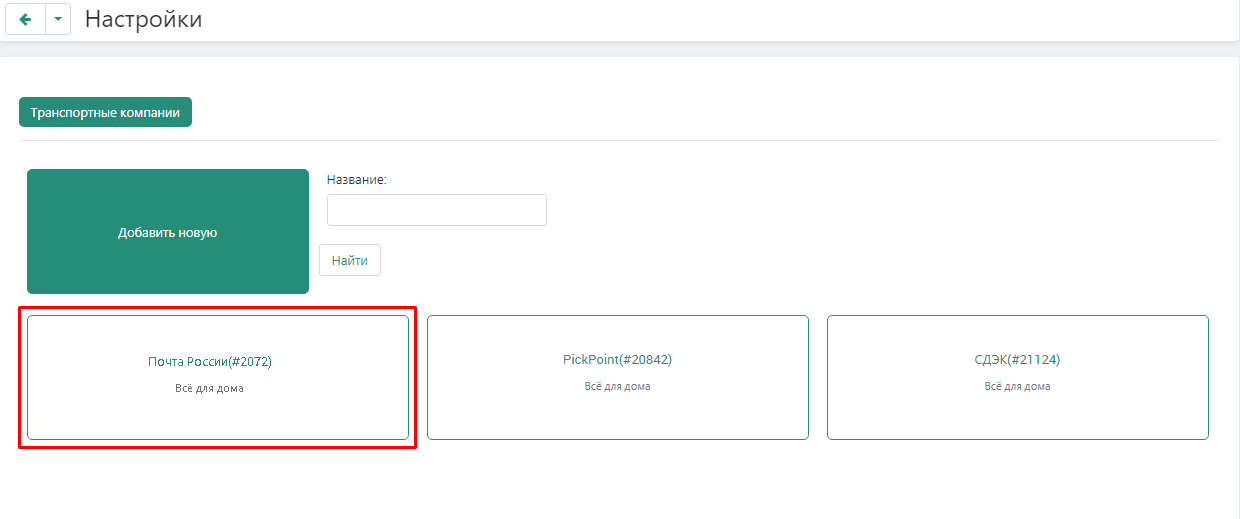
CREATING A DELIVERY METHOD
1. To bring to the showcase the opportunity to choose the services of a specific transport company, you need to create a delivery method.
To do this, go to the "Administration" tab, the "Shipping and Taxes" section and select "Shipping Methods".

2. To create a new delivery method, click on the button in the plus form on the right side of the panel.

3. Enter the name.

4. Expand the additional menu in the "Tariff calculation" item and select "ApiShip".
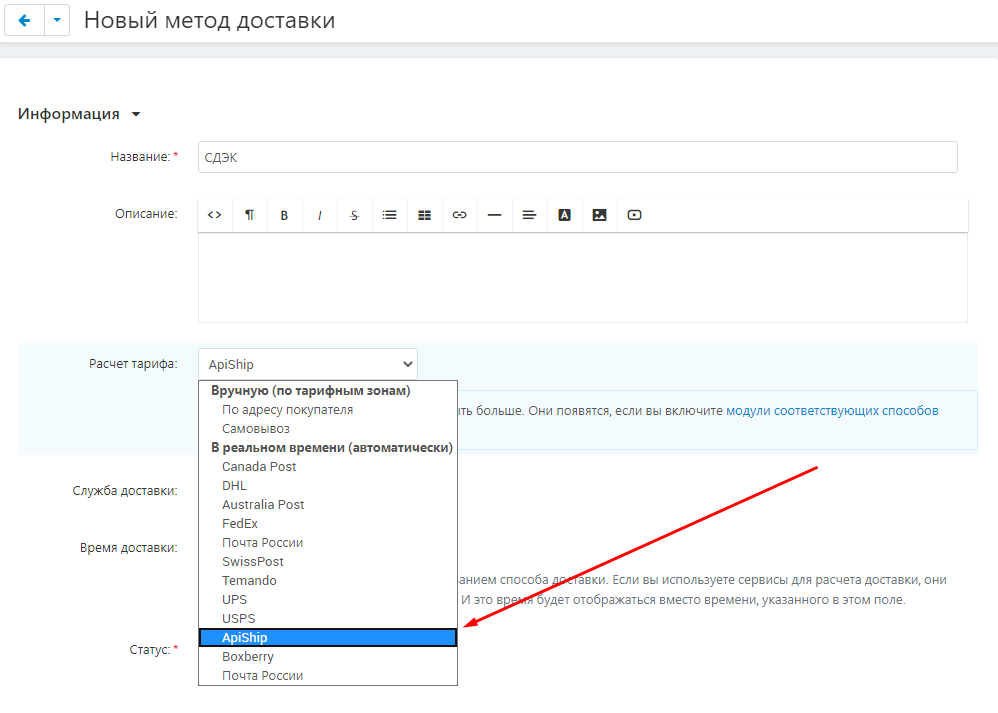
5. Click on the blue "Create" button in the upper right corner of the panel.

6. Go to the "Configure" tab. Check the box if the delivery is paid by the recipient. If the delivery service does not support payment by the recipient, then there will be problems with transferring the order to the TC,
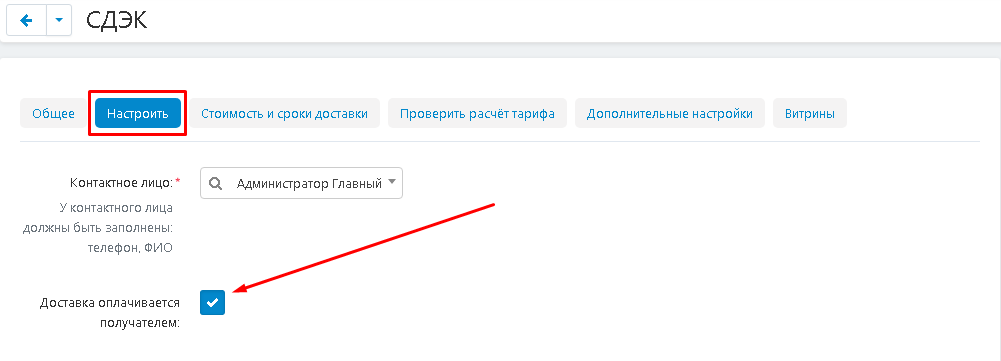
7. In the "Transport company" item, select the delivery service.
Please note that the items marked with a red asterisk are mandatory!
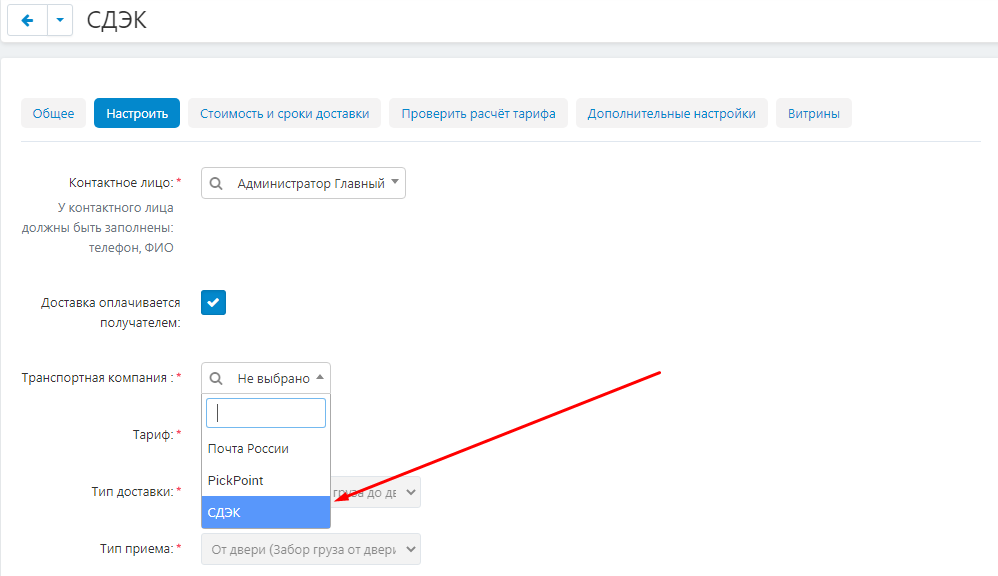
8. In the "Tariff" item, select the desired tariff. Please note that if you want to add different tariffs from the carrier, then you need to create a delivery method for each of them. One delivery method = one tariff.
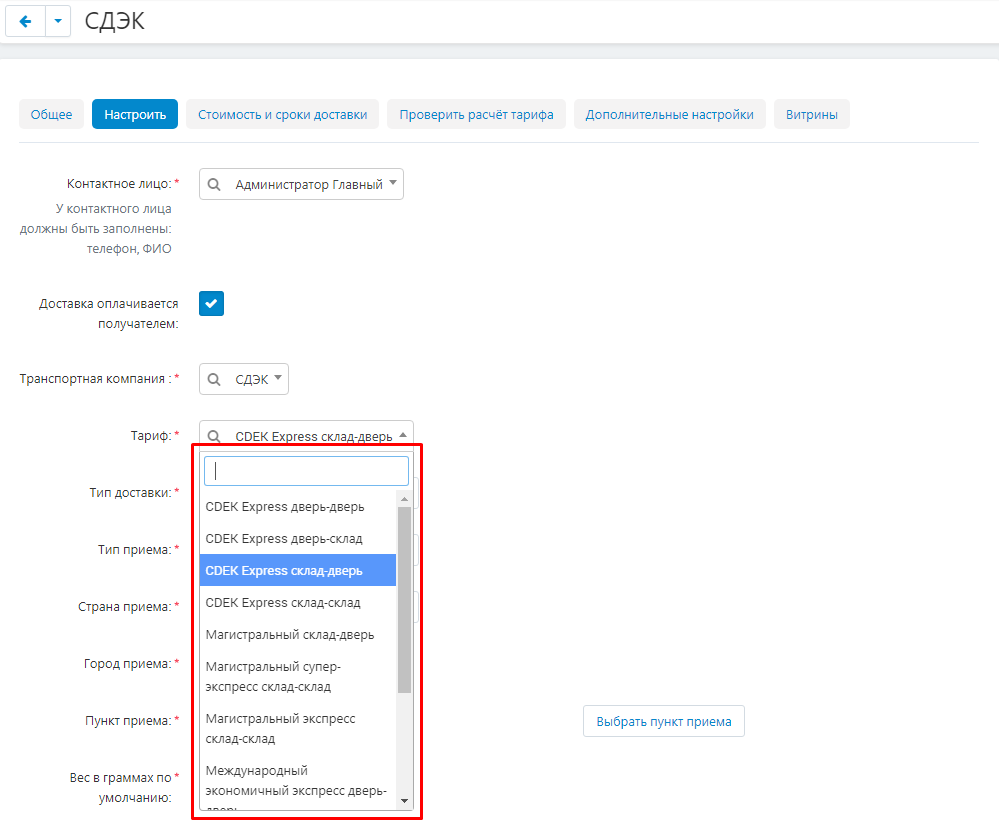
9. If the tariff assumes the presence of PVZ, then it is necessary to enter the city of reception.

10. Click on the "Select a reception point" button.

11. The PVZ catalog will appear. Click on the arrow and select the PVZ by double-clicking on it.

12. The selected PVZ will appear on the page.

13. Fill in the parameters of the weight, length, width and height of the cargo.

14. Go to the "Advanced Settings" tab. In addition to the standard functionality, here you can also turn on and off the buyer's address as mandatory.
If you check the box "The buyer must specify his address",
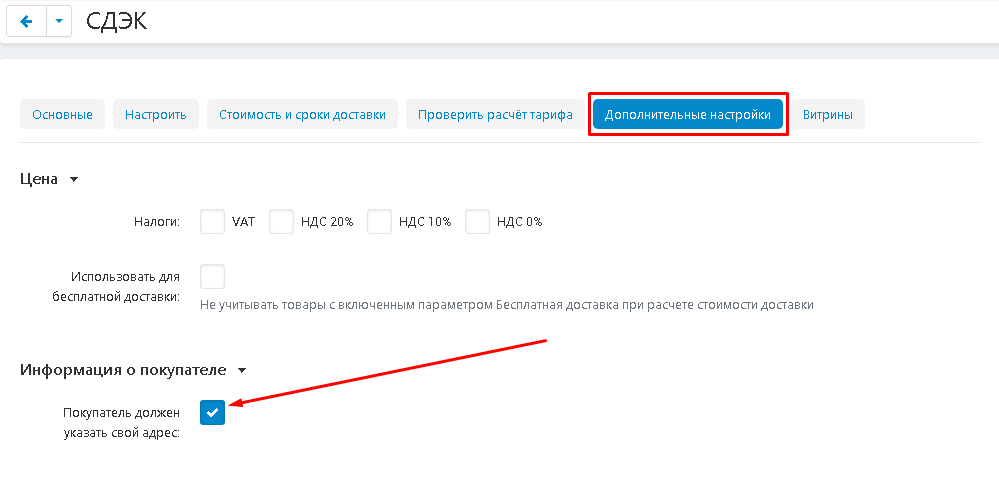
then the buyer's address will be displayed when placing an order and will be mandatory.
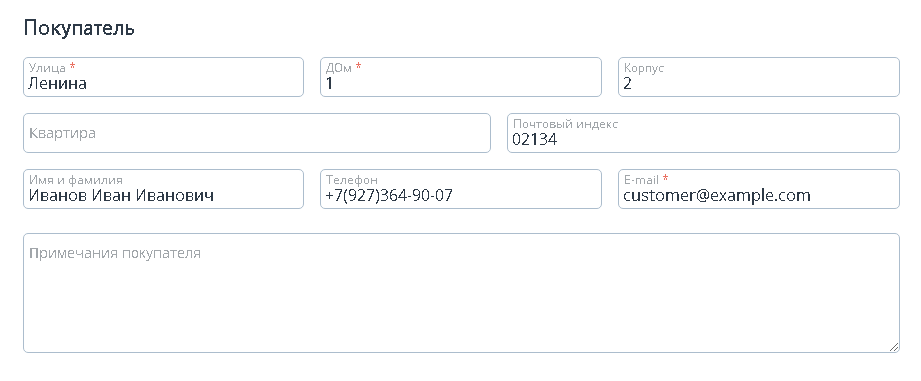
15. If there is no check mark,
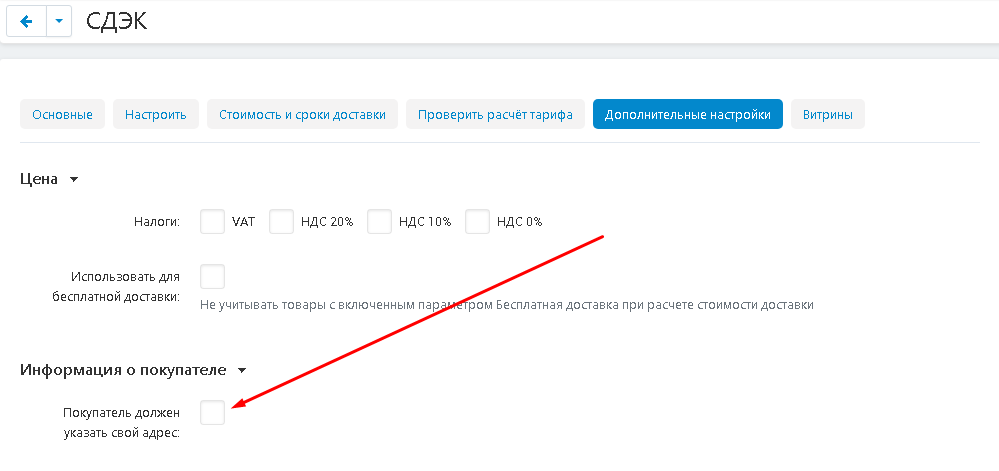
then during the checkout, the address fields for the buyer will not appear.

16. Save the changes by clicking on the blue "Save" button in the upper right corner of the panel.

17. If the delivery method needs to be added to all sellers, click on the button in the form of a blue gear, select "Allow delivery for all sellers". The delivery method will be added for all sellers of the store.

TARIFF PLANS
In some cases, as a result of a failure or error, the delivery method may lose tariff zones. Or, they are not added for the platform. Without specifying the tariff zone, the delivery method will not be displayed on the checkout page. Therefore, it is recommended to check the data in advance.
1. First of all, check if all countries are included. To do this, go to the "Administration" tab, select the "Shipping and Taxes" and "Countries" section.This is especially important when you work in different countries.

2. In the list that appears, select the desired country. Make sure that the status is set to "On" (enabled)
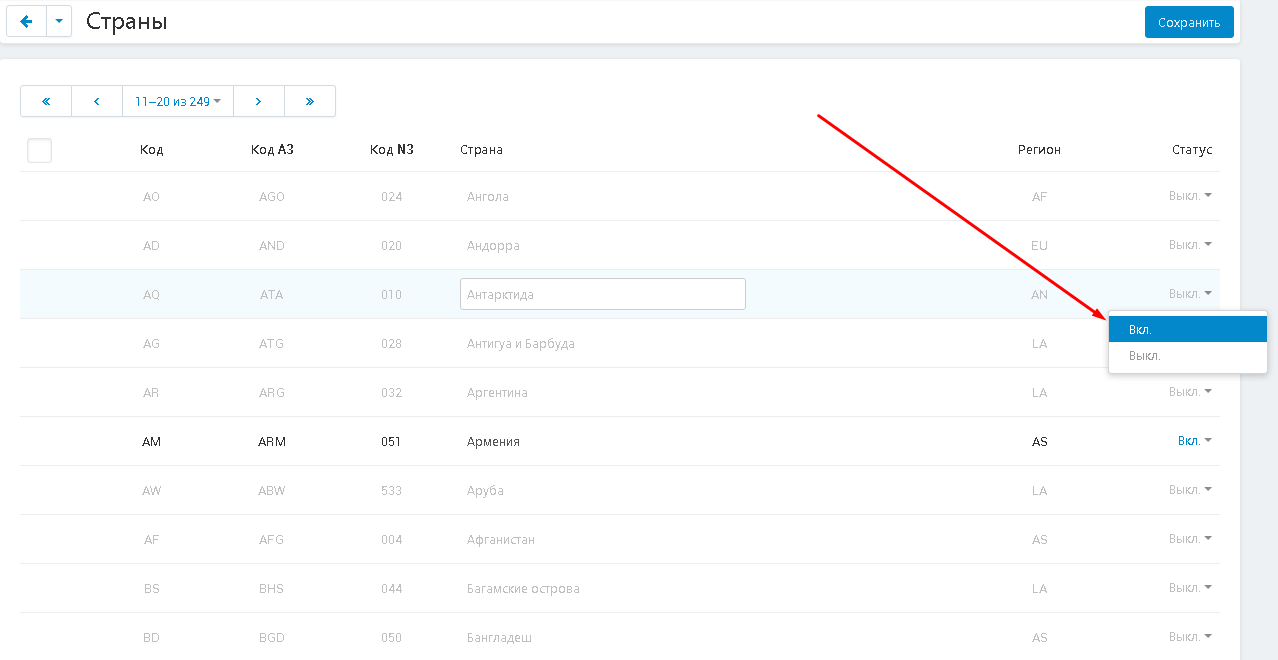
3. Now check the tariff zones. To do this, go to the "Administration" tab, select the "Shipping and Taxes" and "Tariff zones" section.
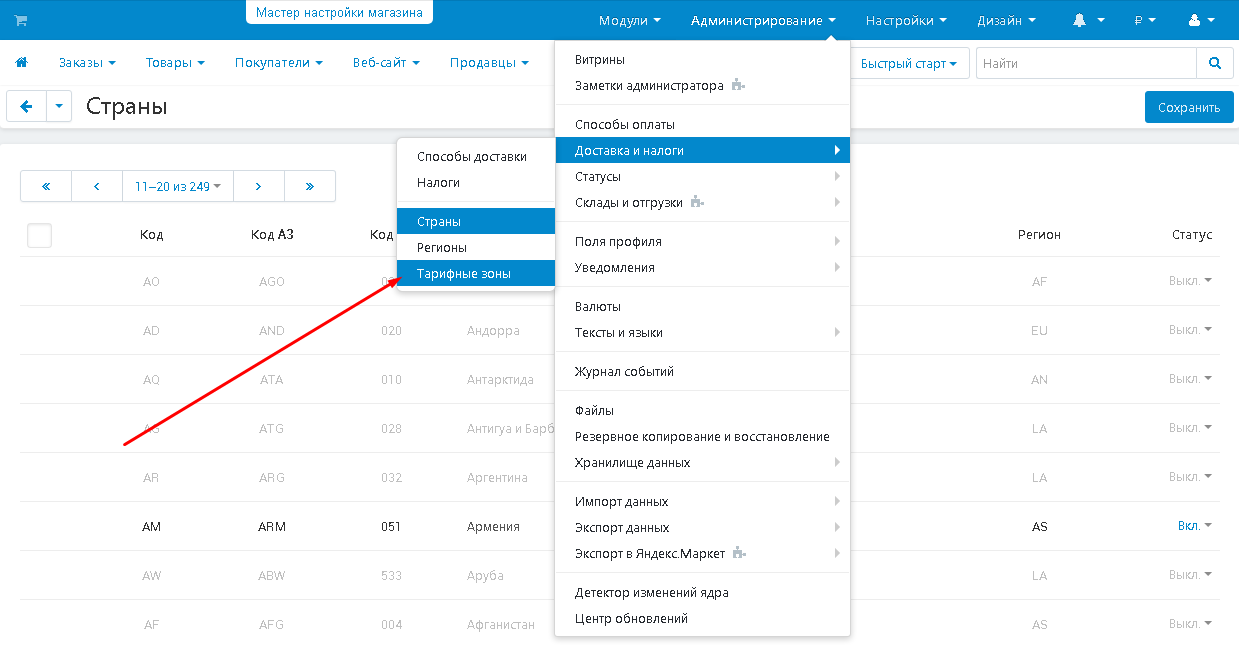
4. Make sure that all the necessary tariff zones are enabled.
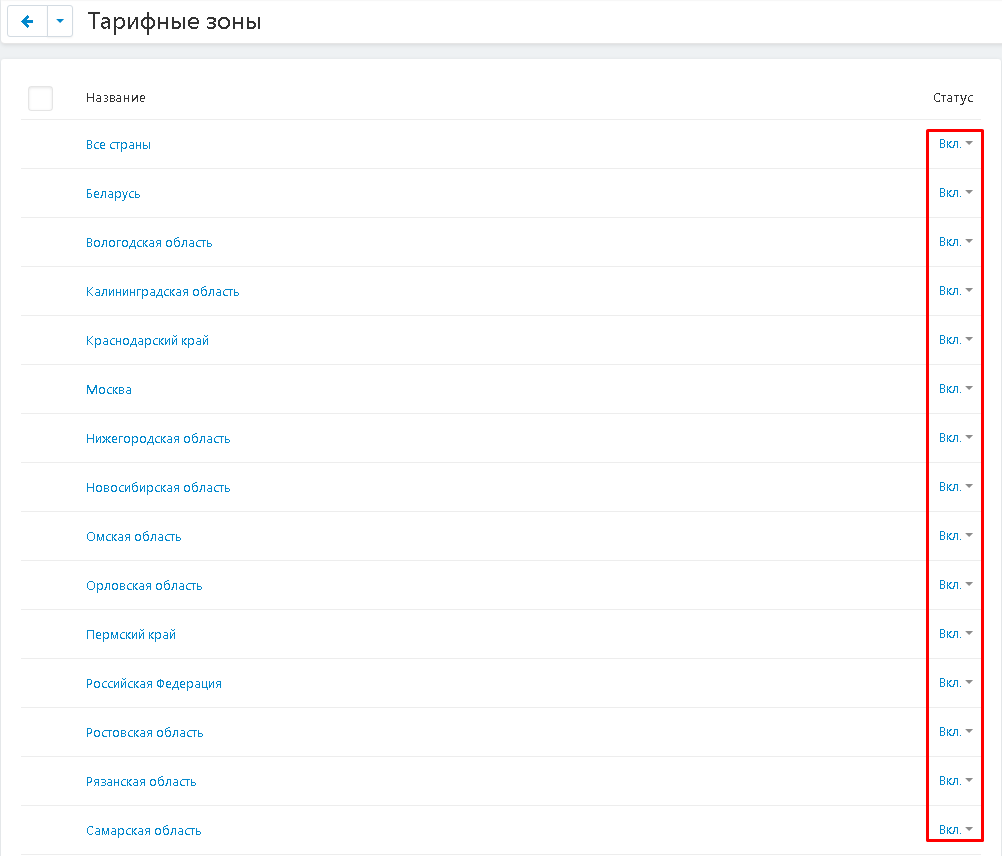
5. If necessary, add a new tariff zone by clicking on the plus button in the upper right corner of the panel.

6. Information about tariff zones is contained in the "Cost and delivery time" tab in any of the delivery methods.

7. If the contents of the tab are completely missing, then a failure has occurred. To enable all available tariff zones at once, click on the "Add all" button.
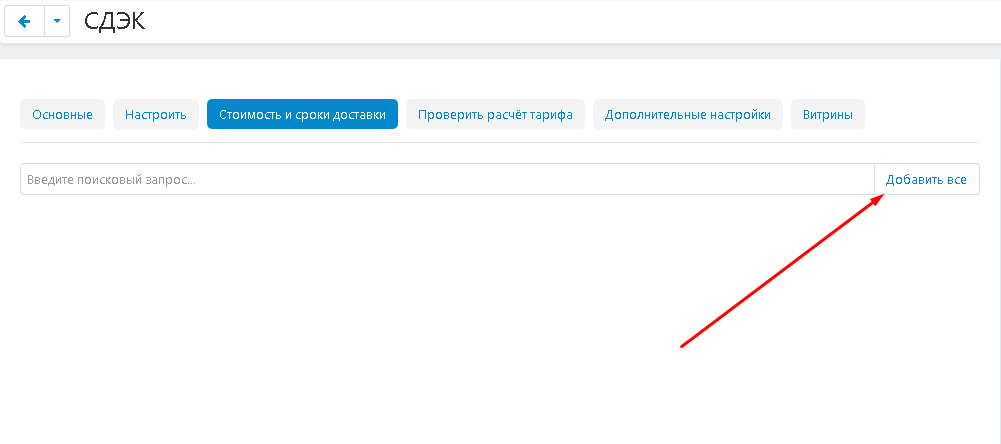
8. Or use the search.
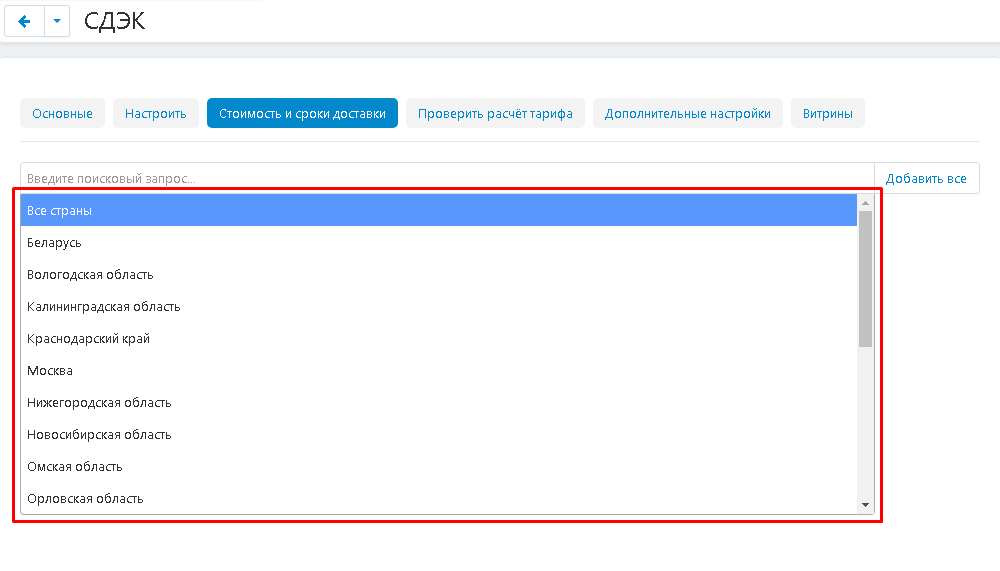
9. The contents of the tab will be filled in.

ORDERING
1. Go to the showcase by clicking on the button in the form of a grocery basket.

2. Make a purchase.
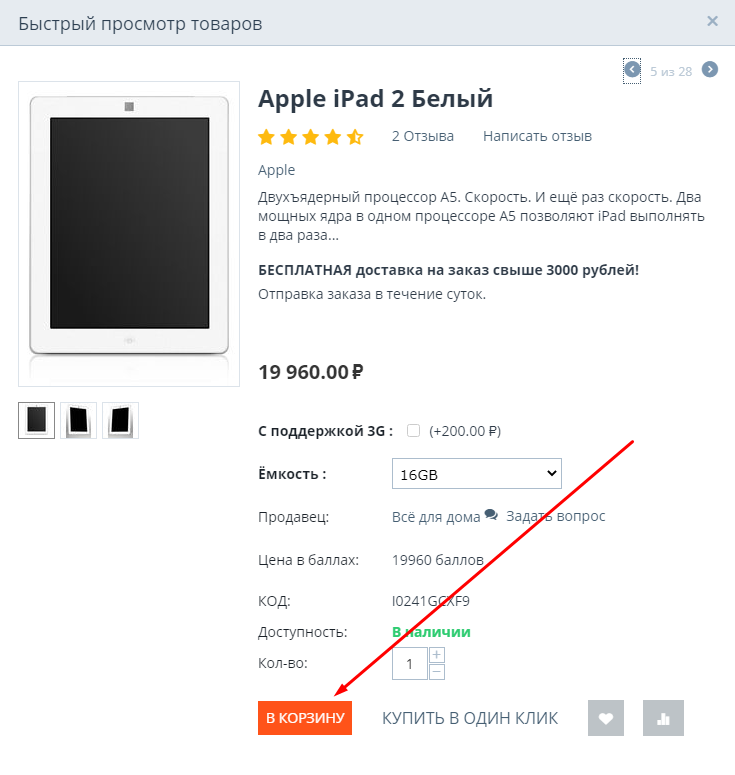
3. The created delivery methods will be displayed on the checkout page.
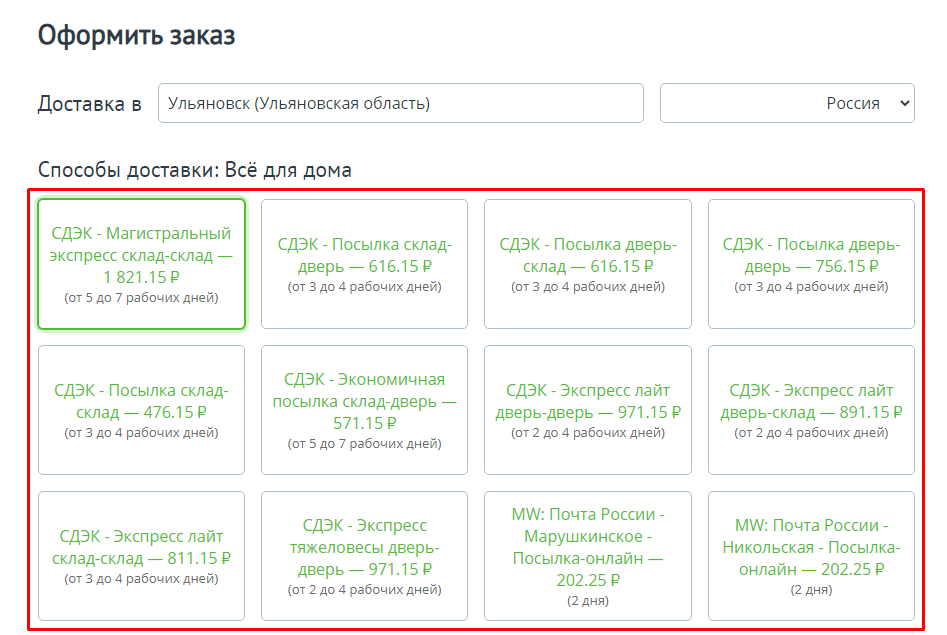
4. When choosing a tariff that implies the presence of a PVZ, a map and a list of pick-up points will open.

5. To select the PVZ, you can use the side menu.
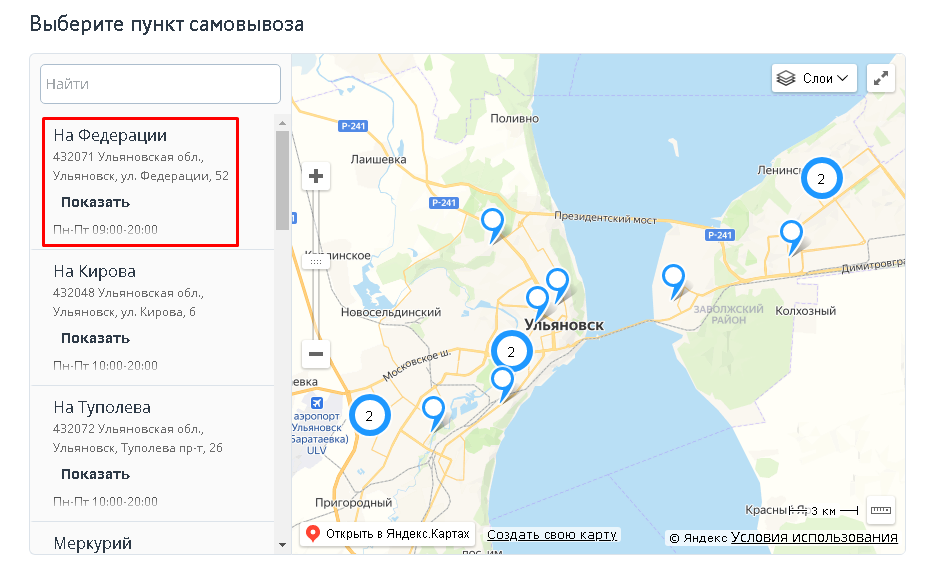
6. Or select the PVZ on the map. If dots with numbers appear on the map, it means that there are several PVZ in this district. Click on the circle with the number.
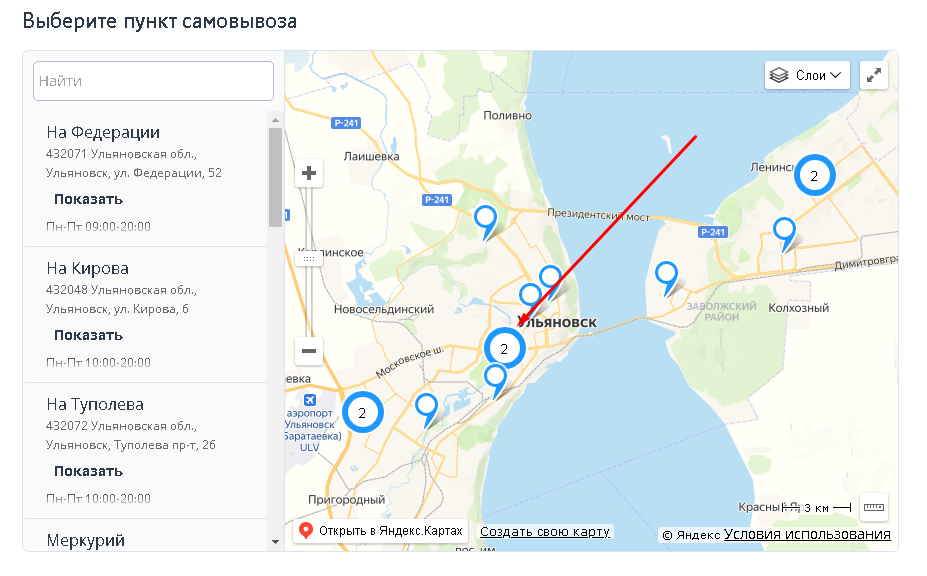
7. The map will zoom in, showing the PVZ in the desired region. Click on one of them to select.
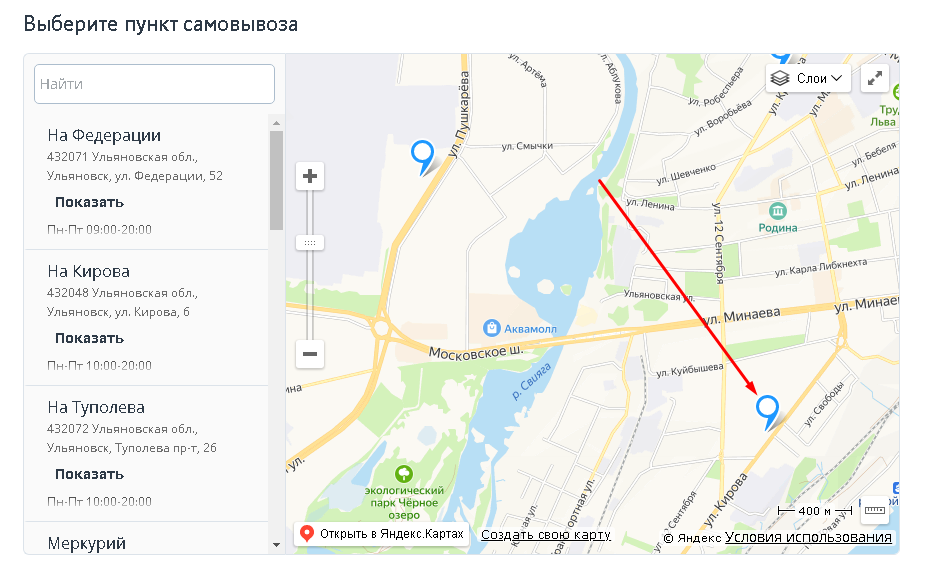
8. A window will open with data about the PVZ: full address, phone number, working hours and landmarks. Click on the red "Select" button to finish selecting the PVZ.
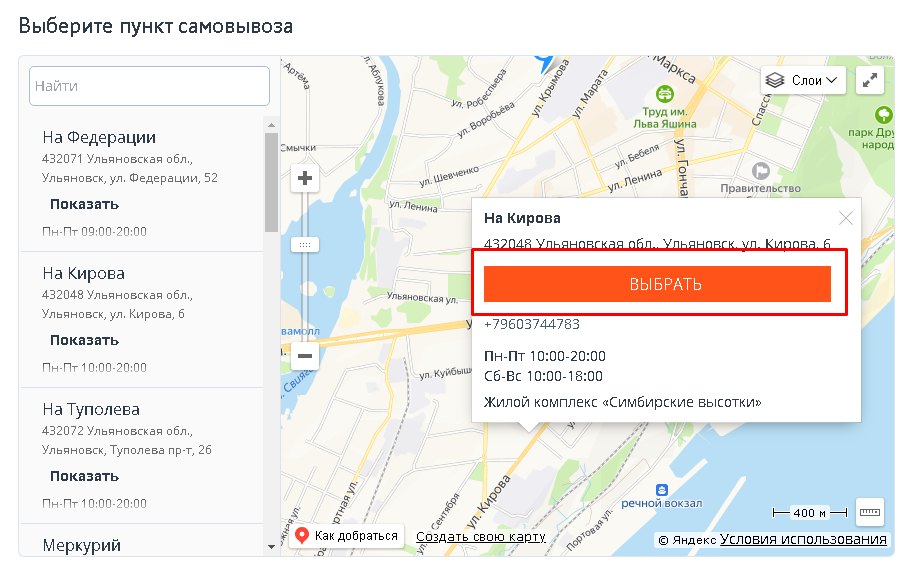
9. Complete the purchase.

CHANGING THE ORDER AFTER REGISTRATION
1. After the order is placed, its further editing takes place in the admin panel. To do this, go to the "Orders" tab and select "All orders".

2. Select an order and click on its name highlighted in blue.

3. The delivery method in the order will be specified exactly the one that the buyer chose.

4. If the order number is changed in the ApiShip Personal Account, it can be entered manually in the "ID in the ApiShip LC" field.
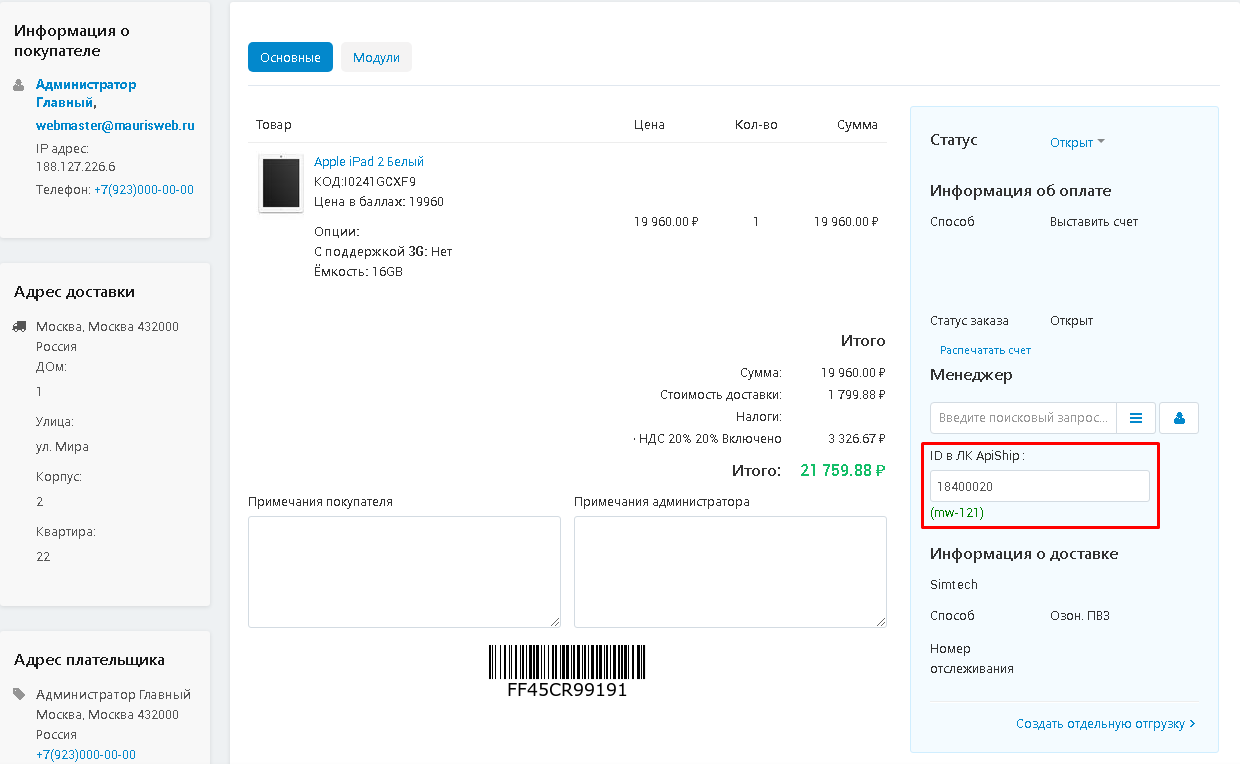
5. To change the order status, click on it, open the additional menu and select the one you want to install
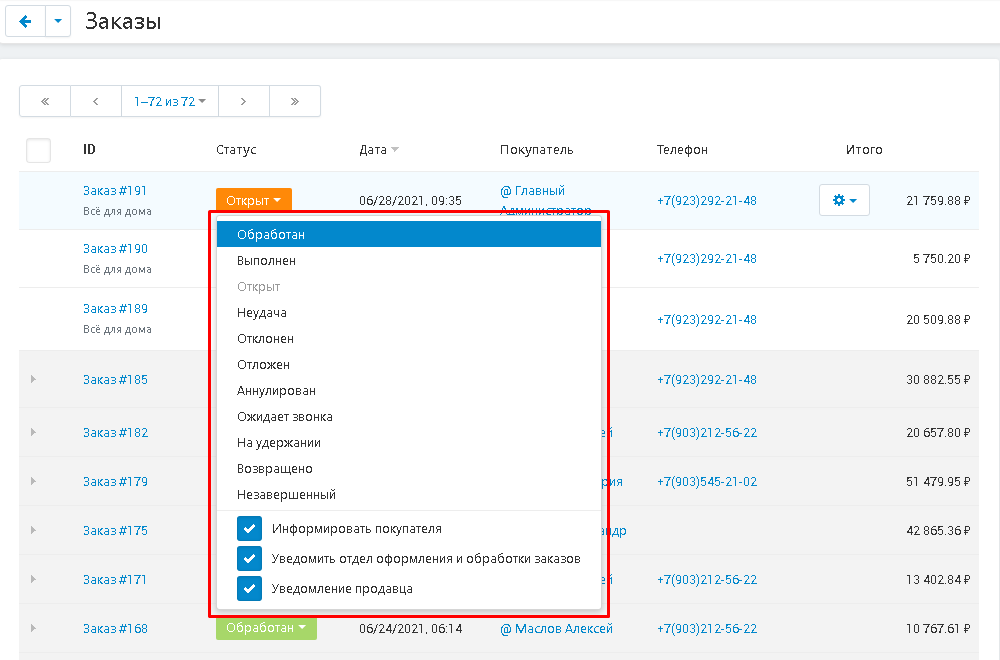
6. To send the selected order to the shopping center, select it, click on the "Actions" button, and then go through "Send selected to the Shopping Center" and one of the options: "New only", "Update existing" or "Create new, update existing".
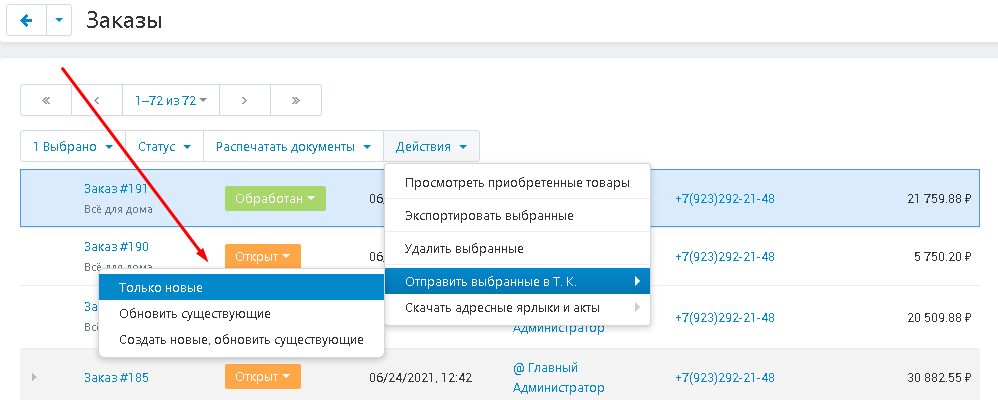
7. The inscription "Sent to Because" will appear under the order status.

8. To download shortcuts, select the function "Download address labels and acts" and "Download address labels". After the formation, the PDF document will be loaded into memory.
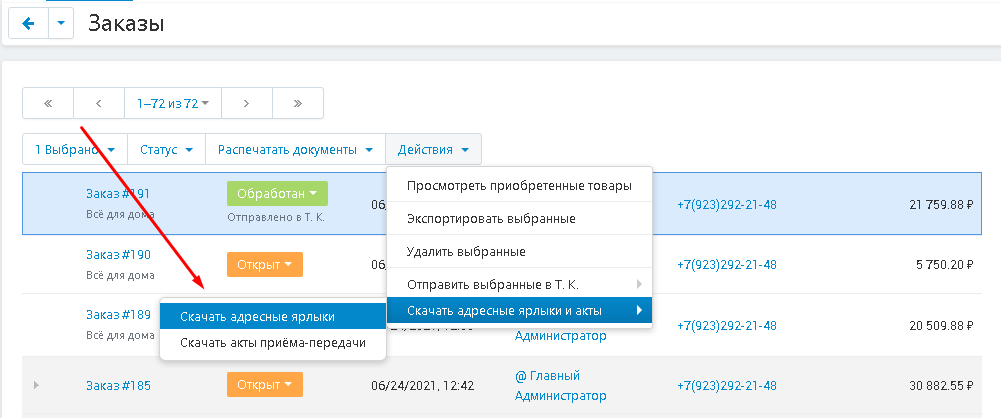
9.To receive the closing documents, select the function "Perform an action in ApiShip for selected orders" and "Download acceptance certificates". The archive with the documents will be loaded into memory.
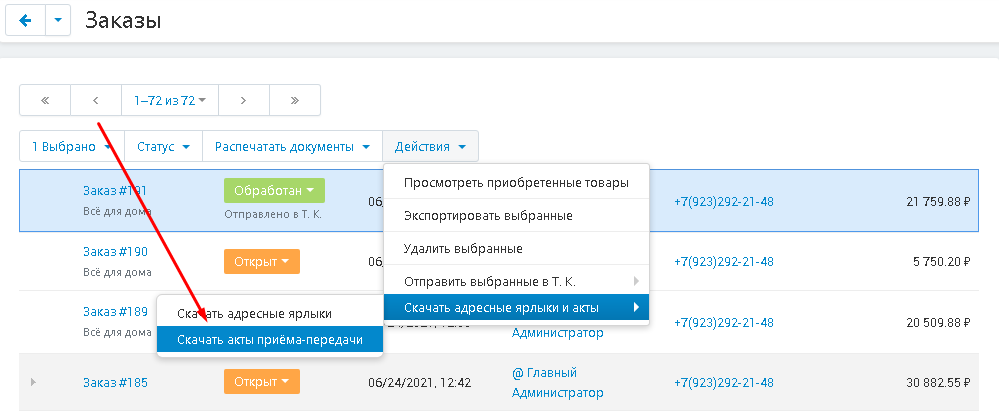
CONTACTS
Up-to-date information about changes in the module's functionality, as well as compatibility with other modules, is published in our Telegram channel and in the VKONTAKTE
Telegram t.me/maurisweb
VKONTAKTEvk.com/maurisweb
You can submit a request to the support service, ask questions to the managers about the work or completion of the module via messengers, the groupVKONTAKTE and mail.
- WhatsApp +7-923-364-90-07
- Telegram t.me/mauriswebru
- Telegram +7-923-364-90-07
- VKONTAKTEvk.com/maurisweb
- E-mail: info@maurisweb.ru
Detailed step-by-step instructions for the module can be found in the "Instructions" section